2006 Social & Environmental
WELCOME!
Within this site, you’ll find our thoughts on how well we delivered on our Company’s Social Mission and our environmental commitments last year. While there is plenty that makes us proud in these pages, you’ll also find a candid evaluation of our shortcomings, trade-offs, and opportunities missed in the social and environmental arena in 2006.
There are three ways to dig into the report:
- Read CEO Walt Freese’s reflections on 2006.
- Read the highlights section to see some photos that tell the story of 2006.
- Use the "Jump To:" menu at the top of each page to navigate to any section of the report.
Why We Do It
We’ve taken time each year since 1989 to compile this report because we continue to believe that it keeps us in touch with our Company’s stated Social Mission. By raising the profile of social and environmental matters inside the Company and recording the impact of our work on the community, this report aids us in our search for business decisions that support all three parts of our Company Mission Statement: Economic, Product, and Social. In addition, the report is an important source of information about the Company for students, journalists, prospective employees, and other interested observers. In this way, it helps us in our quest to keep our values, our actions, and public perceptions in alignment.
This is the second year that we’ve issued the report in a fully-linked, easily navigated online format.
Ben & Jerry’s has not submitted this report to an outside auditor, as we have in years past. Nonetheless, we have followed a thorough internal review process in order to ensure that the information we present here is accurate and truthful. We also receive valuable input on our social reporting from fellow members of the Ceres network. Our longtime social auditor, James E. Heard, has served as a consultant in the process of writing this report, offering candid insights and feedback.
Enjoy!
A LETTER FROM OUR CEO
It’s clear to me that in the hyper-paced world we live in we don’t allow ourselves enough time for reflection. That’s why I believe it’s so important that, for 18 years now, Ben & Jerry’s has written an annual report on our social and environmental performance. This process creates time and space to look back at the path we’ve traveled each year and determine how to stay on course as a values-led business.
This year’s report leads me to several observations. First of all, I’m proud of what we accomplished in 2006, including:
- Expanding our Fair Trade flavors globally, which helps improve the lives of food producers and their families in developing countries around the world.
- Developing sustainable dairy farming programs in both Vermont and the Netherlands that offer great promise for family farmers and our environment.
- Committing to a total phase-in of Certified Humane Cage-Free eggs for our U.S. ice cream production.
- Speaking up for common sense federal budget priorities in the United States that will invest more in the health, education and welfare of our nation’s children and less on nuclear weapons programs.
- Meeting or exceeding all of our environmental goals for our facilities in 2006, including a five-year goal to reduce our greenhouse gas emissions that contribute to global warming.
In addition, American consumers rated Ben & Jerry’s the most socially responsible company in the United States in 2006, according to Golin Harris’ fourth national survey of corporate citizenship.
While all of this is great news, I am also conscious of the fact that two of our highest-profile initiatives in the social and environmental arena last year came in response to external forces. Specifically, Unilever supply chain challenges forced us to rethink our pint packaging material, and consumer pressure expedited our decision to source our eggs from Certified Humane cage-free suppliers. It’s a testament to the folks who work at Ben & Jerry’s and the spirit of our brand that, in each case, we found solutions that responded to our immediate needs and also returned social and environmental benefits.
But as much as possible, we want to be a company that is led by our values, not by circumstances. And our Social Mission calls us to “initiate innovative ways to improve the quality of life” where we do business, not merely to maintain and expand the successful projects of the past. We are called to do more with our business to make the world a better place.
In this spirit, all of us at Ben & Jerry’s are committed to making 2007 a year focused more than ever on values-led innovation. At the top of our list of goals is the completion of our pint packaging conversion that will source Forest Stewardship Council (FSC) certified paperboard from sustainably managed forests and put us on the threshold of a package that comes from totally renewable resources.
Employees will also play a vital role in 2007 by participating in Social Mission work groups, which are designed to bring innovative thinking to all aspects of our business. This process will help bring us even closer to being the transformative business we aspire to be.
We had our challenges in 2006, as you will read in this report. Despite our commitment to lead with our progressive values, we do inevitably make mistakes and we do sometimes fall short of our goals. But it’s the character of our company that we will work with passion and resolve to acknowledge our shortcomings, fix them, and learn from them.
I am proud of the contributions we’ve made in 2006 and the efforts of people throughout Ben & Jerry’s who live out our three-part Mission Statement each and every day.
For me, participating in this conversation within Unilever reinforces the fact that Ben & Jerry’s Social Mission is not a destination, but a journey. We’ll never be able to say we’ve arrived as a perfect company. Rather, we must keep examining our own practices, assessing our impacts, and pursuing honest dialogue to find new ways to make Ben & Jerry’s a better company — and the world a better place.
Thanks for taking the time to read our report.
Peace, Love & Ice Cream
Walt Freese
Chief Euphoria Officer
HIGHLIGHTS IN 2006
The Short & Sweet Version
We hope you’ll take some time to sit down with a bowl of ice cream and savor this report all the way through. But for those of you who like to dig out the gobs of cookie dough first, here’s the abridged story of our social and environmental performance in 2006 to match your style. Don’t forget to come back later to finish the bargain. Here’s how we did…
…in Our Supply Chain
We said goodbye to the Eco-Pint, the unbleached paperboard pint container used to package our ice cream, after nine years. We had hoped that other food companies would join us in moving toward unbleached paperboard packaging, an environmentally friendly material that does not require 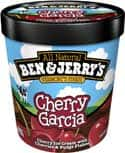 the use of chlorine bleach. But since the market for this kind of packaging never grew much beyond Ben & Jerry’s, we ran into increasing supply, quality, and cost challenges. In the fall of 2006, we transitioned to a new bleached paperboard container for our pints. Our new supplier has an excellent track record of sustainable forestry practices and can help us achieve our long-held goal of finding a non-petroleum based, renewable coating for our pint package. The move away from the Eco-Pint will also allow us to eliminate approximately 1,000 tons of waste annually in our packaging supply chain. All in all, we feel this is a necessary step sideways that will allow us to keep moving forward on our journey to reduce the environmental impacts of our packaging.
the use of chlorine bleach. But since the market for this kind of packaging never grew much beyond Ben & Jerry’s, we ran into increasing supply, quality, and cost challenges. In the fall of 2006, we transitioned to a new bleached paperboard container for our pints. Our new supplier has an excellent track record of sustainable forestry practices and can help us achieve our long-held goal of finding a non-petroleum based, renewable coating for our pint package. The move away from the Eco-Pint will also allow us to eliminate approximately 1,000 tons of waste annually in our packaging supply chain. All in all, we feel this is a necessary step sideways that will allow us to keep moving forward on our journey to reduce the environmental impacts of our packaging.
For years, we’ve sought out suppliers like Greyston Bakery who deliver environmental and social benefits in addition to the ingredients we need to make and package our ice cream. Measured by total dollars, our Values-Led Sourcing declined in 2006, to 49% of our raw material spend (i.e., ingredients, dairy, packaging), driven largely by the low milk prices we saw in 2006. We did not add any new VLS initiatives in 2006, but we did make plans that will likely increase our VLS spend in 2007, including the following:
- We made the decision in 2006 to convert the vanilla extract in our smooth Vanilla ice cream — and the cocoa powder in our smooth Chocolate ice cream — to Fair Trade Certified in 2007. Given the excellent track record and the growing consumer awareness of Fair Trade certification, we’re excited about the change. We will continue to source all of our coffee extract from Fair Trade sources, as we have since 2005.
- We made the decision to transition all of the eggs used in our U.S. ice cream production to Certified Humane cage-free suppliers over a four-year period, beginning in 2007. It took a nudge from the Humane Society of the United States to speed up our process, but this decision makes Ben & Jerry’s one of the very first national food manufacturers to commit to using Certified Humane cage-free eggs.
…in Our Scoop Shops
Our Scoop Shops faced unprecedented competition in many markets  across the country, resulting in a difficult year for some of our franchisees. Overall sales in our franchise system were flat. Meanwhile, a US- based columnist wrote an article in the UK-based magazine Ethical Corporation that questioned the integrity of our earnings claim in our franchise legal documents. We sent an honest and comprehensive reply to the magazine to defend our practices, but the article stung a bit, particularly among our franchise community.
across the country, resulting in a difficult year for some of our franchisees. Overall sales in our franchise system were flat. Meanwhile, a US- based columnist wrote an article in the UK-based magazine Ethical Corporation that questioned the integrity of our earnings claim in our franchise legal documents. We sent an honest and comprehensive reply to the magazine to defend our practices, but the article stung a bit, particularly among our franchise community.
Three new Ben & Jerry’s PartnerShops opened in 2005, while one closed. A PartnerShop is a Scoop Shop owned and operated by a community-based nonprofit organization that offers job training and paid work experience to youth who may face barriers to employment. We’re committed to supporting this unique franchise model and our nonprofit partners, though it has never been an easy road.
Coast to coast, Ben & Jerry’s Scoop Shop teams rolled up their sleeves and contributed over $600,000 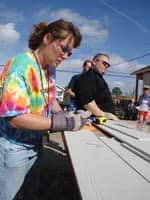 in product donations, cash, and employee time to support local community projects. From relief efforts to blood drives to fundraisers, our franchisees are finding ways to make a positive impact in their own neighborhood.
in product donations, cash, and employee time to support local community projects. From relief efforts to blood drives to fundraisers, our franchisees are finding ways to make a positive impact in their own neighborhood.
In its 28th year of Scoop Shop tradition, Ben & Jerry’s Free Cone Day served up some 1.4 million free scoops to ice cream lovers worldwide, extending thanks to our neighbors while helping local nonprofit partners to spread the word about their mission. In all, the global event raised over $272,000 for hundreds of organizations in communities where Ben & Jerry’s franchisees are doing well by doing good.
In a new program we call Scoopers Making Change, we asked Ben & Jerry’s scoopers around the country to send us their ideas for how to promote positive social change in their own communities. We read through the proposals and invited nine scoopers to Vermont for a jam-packed week of work and play. During their stay with us, these activists-in-training developed their ideas and community organizing skills, refined their action plans, and energized our entire office with their idealism and passion. We sent each scooper home with a grant of up to $1,000 from Ben & Jerry’s to help with project implementation.
we asked Ben & Jerry’s scoopers around the country to send us their ideas for how to promote positive social change in their own communities. We read through the proposals and invited nine scoopers to Vermont for a jam-packed week of work and play. During their stay with us, these activists-in-training developed their ideas and community organizing skills, refined their action plans, and energized our entire office with their idealism and passion. We sent each scooper home with a grant of up to $1,000 from Ben & Jerry’s to help with project implementation.
…for the Environment
We reached and exceeded all of the environmental performance goals at our Vermont manufacturing plants, reducing our water use, solid waste, product waste, and greenhouse gas emissions while increasing recycling.
We reached our Company’s goal to reduce our normalized CO2 emissions (emissions per gallon of product) by 10% over the five year period from 2002 to the end of  2006. Overall, we achieved a 32% reduction in normalized CO2 emissions in these five years. On an absolute basis, we generated 2% more CO2 emissions in 2006 over our 2002 levels, while our production increased by double digits. In addition, we offset the environmental impact of 100% of these emissions through the purchase of “carbon offsets” from NativeEnergy.
2006. Overall, we achieved a 32% reduction in normalized CO2 emissions in these five years. On an absolute basis, we generated 2% more CO2 emissions in 2006 over our 2002 levels, while our production increased by double digits. In addition, we offset the environmental impact of 100% of these emissions through the purchase of “carbon offsets” from NativeEnergy.
We began a focused effort in 2006 to put our CO2 emissions in a broader perspective by calculating a new metric known as Ben & Jerry’s Global Warming Social Footprint. Working with the Center for Sustainable Innovation, we compared our manufacturing carbon dioxide emissions to one of the most aggressive global plans to combat global warming, known as the WRE350 Plan. We found that our performance over the last six years narrowly missed the targets of the WRE350 Plan. Going forward, the footprint gives us valuable targets to aim for as we shape our long-term climate change strategy.
We continue to work closely with  the farmers who supply our milk and cream on both sides of the Atlantic, to help them implement sustainable practices on the farm. In 2006, we brought 11 farmers and their families and several project advisors from our European Caring Dairy program to Vermont where they discussed best practices with some of the farmers in our Dairy Stewardship Alliance. Participants told us the exchange was a valuable experience on the path to improved environmental, social, and economic outcomes on their farms.
the farmers who supply our milk and cream on both sides of the Atlantic, to help them implement sustainable practices on the farm. In 2006, we brought 11 farmers and their families and several project advisors from our European Caring Dairy program to Vermont where they discussed best practices with some of the farmers in our Dairy Stewardship Alliance. Participants told us the exchange was a valuable experience on the path to improved environmental, social, and economic outcomes on their farms.
In response to the growing cost of energy and the concerns about climate change, we partnered with the Vermont Environmental Consortium and the Vermont Dairy Task Force to develop The Farm Energy Handbook. The handbook was sent to every dairy farmer in Vermont to help them evaluate whether alternative energy systems, such as methane biodigesters, solar panels, or wind turbines are financially viable options for their farm.
…in the Workplace
In 2006, our parent Company, Unilever, announced that it will outsource worldwide HR functions to Accenture. The pending change required the alignment of Ben & Jerry’s benefits with the rest of Unilever North America, which resulted in some significant changes to employee benefits packages in 2006. We still offer competitive benefits and some perks you’re not likely to find elsewhere.
…in the Community
From Ben & Jerry’s headquarters, we devoted over $3.2 million in resources to hundreds of projects and groups that promote positive 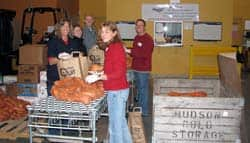 and environmental change. Starting with the Company’s contribution to the Ben & Jerry’s Foundation and extending to product donations, flavor royalties paid to nonprofit organizations, community service, and issue-based marketing, we put more money, ice cream, and employee time than ever towards issues and actions we believe in. Learn more about the ways we give back to the community.
and environmental change. Starting with the Company’s contribution to the Ben & Jerry’s Foundation and extending to product donations, flavor royalties paid to nonprofit organizations, community service, and issue-based marketing, we put more money, ice cream, and employee time than ever towards issues and actions we believe in. Learn more about the ways we give back to the community.
The Ben & Jerry’s Foundation continued its high-impact grant-making to progressive organizations working to address the root causes of social and environmental problems in our nation. 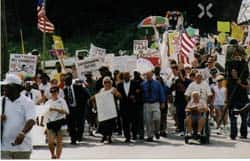 Our Company allocated $1,587,917 to the Foundation in 2006, a 9% increase, and the Foundation awarded grants totaling $1,333,985 over the course of the year. Two of our past grantees won national awards for their work in 2006.
Our Company allocated $1,587,917 to the Foundation in 2006, a 9% increase, and the Foundation awarded grants totaling $1,333,985 over the course of the year. Two of our past grantees won national awards for their work in 2006.
One year after Hurricane Katrina, we sent another team of seven employees to the Gulf Coast for a week to help with the deconstruction and clean-up of storm-damaged homes. Ben & Jerry’s paid for the crew’s time and travel.
…in the Public Eye
With our American Pie ice cream — and our progressive Company values — leading the way, we launched our American Pie Campaign calling for common sense priorities in the federal budget. We gave away samples of the ice cream on an eight city U.S. tour and developed an interactive American Pie website to highlight the fact that millions of American children live in poverty while we spend tens of billions of dollars each year on nuclear weapons. Our campaign collected thousands of postcards to send to Congress.
We were so inspired by An Inconvenient Truth, Al Gore’s 2006 documentary film on global warming, that we decided to bring the DVD version to as many people as possible in our own backyard and around the country. Working with the Vermont Department of Education and Vermont Public Interest Research Group, Ben & Jerry’s provided a free DVD of the film to every high school in Vermont. We also promoted the film on college campuses around the country as a part of Truth on Campus and in Ben & Jerry’s Scoop Shops.
We launched a Cool Your Jets initiative to educate the public about the value of carbon offsets  in the fight against global warming — and to give people the chance to offset the carbon dioxide emissions from their personal air travel by funding the construction of new renewable energy projects. With our friends at NativeEnergy in the U.S. and myclimate in Europe, the initiative resulted in the purchase of 482,000 pounds of carbon offsets for 443,600 miles of airplane travel, in its first three months.
in the fight against global warming — and to give people the chance to offset the carbon dioxide emissions from their personal air travel by funding the construction of new renewable energy projects. With our friends at NativeEnergy in the U.S. and myclimate in Europe, the initiative resulted in the purchase of 482,000 pounds of carbon offsets for 443,600 miles of airplane travel, in its first three months.
Ben & Jerry’s introduced a new line of bottled milkshakes and dedicated a portion of the proceeds to the purchase of carbon offsets through Clean Air, Cool Planet , which provides funding for the construction of new renewable energy projects. In 2006, these carbon offsets totaled $102,107, which will fund projects equivalent to taking thousands of cars off the road for a year.
Our Consumer Affairs folks were inundated when thousands of people, spurred on by the Humane Society of the United States, called or wrote to encourage us to source our eggs from cage-free suppliers. In October, Ben & Jerry’s announced that it will transition to using entirely Certified Humane cage-free eggs over a four-year period beginning in 2007. It’s fair to say that consumer voices raised the profile of this issue within our supply chain and sped up a decision that we had been contemplating for some time. In the months that followed, we were pleased to get many more calls thanking us for being one of the first major food manufacturers in the U.S. to source Certified Humane cage-free eggs.
…around the World
In July 2006, Ben & Jerry’s introduced Europe’s first ice cream made with Fairtrade Certified ingredients: Ben & Jerry’s Fairtrade Vanilla. 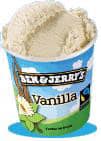 All of the vanilla extract — and sugar — used in this ice cream are produced by cooperatives of farmers who are guaranteed to earn a fair price for their crops; have access to reasonable credit; and use environmentally sound methods of cultivation. We’re proud to be a part of the growing Fairtrade movement around the world that is helping small farmers in the developing world to earn a decent living, stay on their land, and send their children to school.
All of the vanilla extract — and sugar — used in this ice cream are produced by cooperatives of farmers who are guaranteed to earn a fair price for their crops; have access to reasonable credit; and use environmentally sound methods of cultivation. We’re proud to be a part of the growing Fairtrade movement around the world that is helping small farmers in the developing world to earn a decent living, stay on their land, and send their children to school.
In Europe, Ben & Jerry’s Climate Change College entered its second year, continuing work with polar explorer Marc Cornelissen and the World Wide Fund for Nature (WWF) to raise awareness of climate change and motivate public action in Europe to reduce greenhouse gas emissions. 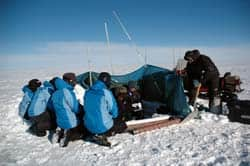 In May 2006, our first class of climate change ambassadors traveled to Greenland on a two-week expedition to perform hands-on climate research on the ice cap and to meet Inuit people who are experiencing some of the most dramatic effects of climate change. The experience prepared these young people to lead awareness campaigns in their home countries in support of WWF’s climate change action initiative. We chose our second class of ambassadors from thousands of applicants in the UK, Holland, Ireland, and Germany.
In May 2006, our first class of climate change ambassadors traveled to Greenland on a two-week expedition to perform hands-on climate research on the ice cap and to meet Inuit people who are experiencing some of the most dramatic effects of climate change. The experience prepared these young people to lead awareness campaigns in their home countries in support of WWF’s climate change action initiative. We chose our second class of ambassadors from thousands of applicants in the UK, Holland, Ireland, and Germany.
OUR COMPANY
Ben & Jerry’s Homemade, Inc.
Ben & Jerry’s has been making the finest all natural ice cream since 1978 when grade school buddies Ben Cohen and Jerry Greenfield opened their first Scoop Shop in Burlington, Vermont. Though we’ve never strayed from the boys’ original dream to create unique and euphoric  ice cream flavors — while making a positive impact along the way — we have grown and changed in all sorts of ways. Today, Ben & Jerry’s is owned by Unilever, and our packaged ice cream and novelties are sold in stores across the U.S. and in 23 other countries around the world. We also have 550 Scoop Shops in operation around the globe.
ice cream flavors — while making a positive impact along the way — we have grown and changed in all sorts of ways. Today, Ben & Jerry’s is owned by Unilever, and our packaged ice cream and novelties are sold in stores across the U.S. and in 23 other countries around the world. We also have 550 Scoop Shops in operation around the globe.
Company Timeline
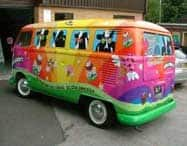 To learn more about the journey from our humble beginnings to where we are today, take a look at our Company timeline. We think you’ll agree that it’s been quite a wild ride.
To learn more about the journey from our humble beginnings to where we are today, take a look at our Company timeline. We think you’ll agree that it’s been quite a wild ride.
Company Profile
Check out the latest on the scope of our business.
Ben & Jerry’s Mission
We’re still a Company on a mission! Read our three-part Mission Statement that has inspired our Company since 1988, along with other guiding statements.
Governance
As a wholly-owned subsidiary of Unilever, we are governed by North American Ice Cream in Green Bay, Wisconsin, as well as an outside Board of Directors.
In a Nutshell...
Ben & Jerry’s Homemade, Inc., a wholly-owned subsidiary of Unilever, is a Vermont-based corporation which manufactures and markets super premium ice cream, frozen yogurt, ice cream novelties and sorbet. Our products are produced in pints, quarts, 500 ml cups, 2.4-gallon tubs, single-serve cups and individual novelties. Ben & Jerry’s products are distributed nationwide and internationally in supermarkets, grocery stores, convenience stores, Scoop Shops, restaurants and other venues.
Ben & Jerry’s franchises Scoop Shops in both the US and Canada. Outside of North America, Ben & Jerry’s products are marketed and distributed by affiliated companies within Unilever and, in Israel, by a third party licensee.
Operations
Ben & Jerry’s ice cream for the North American market is made in our plants in Waterbury and St. Albans, Vermont. We also make Ben & Jerry’s ice cream for the European market in a Unilever facility in Hellendoorn, the Netherlands and for the Canadian market in a Unilever facility in Simcoe, Ontario. Our frozen novelties are manufactured at Unilever facilities in Sikeston, Missouri; Hagerstown, Maryland; and by Rhino Foods in South Burlington, Vermont.
At the end of 2006, Ben & Jerry’s employed 514 people in the United States as compared to 505 in 2005.
Yearly Revenue
AAs a wholly-owned subsidiary of Unilever, Ben & Jerry’s is part of a larger multinational publicly-traded business. For the purpose of this report, the Company reports financial results based on an annual revenue reporting range provided by the Global Reporting Initiative (GRI). For 2006, Ben & Jerry’s revenue was between $200 million and $500 million.
Global Business
Our global business continues to grow as people around the world discover the euphoric experience that is Ben & Jerry’s ice cream. Learn more about our activities in overseas markets.
Our Three Part Mission Statement
We have a statement of mission nearly as old as our brand. When people ask, as they often do, how we make our daily decisions and what we mean by “values-led business,” we point to our Mission Statement, the glue that holds things together — campaigns and causes, employee benefits, best practices and business decisions, platforms, position statements and projects of every kind.
Here’s how it reads:

If you would like to read our Mission Statement in depth you can find it here as well.
Since the year 2000, it’s been reasonable to ask how Ben & Jerry’s acquisition by Unilever has affected our ability to deliver on our Company’s Mission Statement, most specifically the Social Mission. While the mix of active projects and initiatives inspired by our Social Mission is constantly changing, our core values remain consistent. To cite a few examples, we are still committed to our partnership with the Vermont family farmers of the St. Albans Cooperative Creamery; to reducing our environmental impacts; to paying our employees a livable wage; to using the power of our brand to draw attention to important issues like global warming, federal budget priorities, and the struggle of family farms in America.
In a few areas, however, Social Mission projects have lost some momentum in recent years. Our Values-Led Sourcing program, for example, has not grown as rapidly as we would like. A comprehensive proposal to include Fair Trade ingredients in more Ben & Jerry’s products in 2006 was not seen as economically viable and was pared back in 2006. While we were pleased to add Vanilla and Chocolate to our Coffee Fair Trade flavors, we fell short of additional Fair Trade ingredients for other flavors. We did initiate plans in 2006 to transition to 100% Certified-Humane cage-free eggs, making us one of the first national food manufacturers in the U.S. to do so. Unfortunately, it took prompting from the Humane Society of the United States (HSUS) to point out to us that the conventional source of our eggs did not live up to our mission and values. And while we did respond to the egg revelation with diligence and resolve consistent with what Ben & Jerry’s stands for, we realized that we need to be more aware and on top of issues such as this. As a result, we’ve recommitted ourselves to a proactive program for our Values-Led Sourcing so that it doesn’t drift or stagnate from lack of proper care and attention.
Our workplace and Company culture has been strained by restructuring in the last several years. In a few cases key vacancies went unfilled in 2006 or the work consolidated into the workload of others. The outsourcing of a variety of financial, computer support and human resource services continues to gently tax the time and energy of people within the company.
We believe that in 2006 we made important headway in learning how to operate with our progressive values within the larger, more complex organization of Unilever’s North American Ice Cream (NAIC). Our commitment is to educate Ben & Jerry’s employees and our counterparts in NAIC about our Social Mission and to fully engage in an ongoing, healthy, and vigorous debate about how Ben & Jerry’s and Unilever can work together for shared success and for positive results on the triple-bottom-line of both companies.
We took a grass-roots approach to addressing how to best reenergize the Social Mission throughout the organization. We conducted an unscientific poll of our management and employees to find out what values and actions would bring new life to our Social Mission. We found out that employees wanted to be more involved in planning and carrying out Social Mission initiatives and that our employees bring tremendous knowledge and passion to the process that can enrich our Social Mission. In the end we arrived at an action plan with the goal of reengaging people at all levels of the company through employee-led Social Mission working groups. These groups will develop and execute new and ongoing projects that will strengthen our Social Mission with the ultimate goal to guide us back to a leadership position as a values-led company.
The Social Mission working group action plan will be carried out in 2007. In summary, here’s how it will work: two employee-led workgroups, Fairness and Sustainability, will go through a process of discovery and research during the first half of 2007, with the goal to produce Social Mission proposals to be presented to our senior leadership team (the MOM) by mid 2007 for approval. Following approval by the MOM team, the proposals would enter the production phase during the second half of 2007, with the goal of executing the proposals in the 2008 operational year.
Other Guideposts
While our Mission Statement is the essential document that keeps us all pulling together in the same direction, we also look to two other documents to guide us as we strive to leverage the power of our business to create positive social and environmental impacts.
Our statement on progressive values expands on our Social Mission statement to articulate what we mean when we talk about improving the quality of life in the communities where we have a presence.
Leading with Progressive Values Across Our Business
We have a progressive, nonpartisan Social Mission that seeks to meet human needs and eliminate injustices in our local, national, and international communities by integrating these concerns into our day-to-day business activities. Our focus is on children and families, the environment and sustainable agriculture on family farms.
- Capitalism and the wealth it produces do not create opportunity for everyone equally. We recognize that the gap between the rich and the poor is wider than at any time since the 1920s. We strive to create economic opportunities for those who have been denied them and to advance new models of economic justice that are sustainable and replicable.
- By definition, the manufacturing of products creates waste. We strive to minimize our negative impact on the environment.
- The growing of food is overly reliant on the use of toxic chemicals and other methods that are unsustainable. We support sustainable and safe methods of food production that reduce environmental degradation, maintain the productivity of the land over time, and support the economic viability of family farms and rural communities.
- We seek and support nonviolent ways to achieve peace and justice. We believe government resources are more productively used in meeting human needs than in building and maintaining weapons systems.
- We strive to show a deep respect for human beings inside and outside our company and for the communities in which they live.
CERES Principles
In 1992, Ben & Jerry’s signed the CERES Principles to acknowledge our responsibility for the environment. The ten aspirational principles guide us in all aspects of our business as responsible stewards of the environment by operating in a manner that protects the earth.
Protection of the Biosphere
We will reduce and make continual progress toward eliminating the release of any substance that may cause environmental damage to the air, water, or the earth or its inhabitants. We will safeguard all habitats affected by our operations and will protect open spaces and wilderness, while preserving biodiversity.
Sustainable Use of Natural Resources
We will make sustainable use of renewable natural resources, such as water, soils and forests. We will conserve nonrenewable natural resources through efficient use and careful planning.
Reduction and Disposal of Wastes
We will reduce and where possible eliminate waste through source reduction and recycling. All waste will be handled and disposed of through safe and responsible methods.
Energy Conservation
We will conserve energy and improve the energy efficiency of our internal operations and of the goods and services we sell. We will make every effort to use environmentally safe and sustainable energy sources.
Risk Reduction
We will strive to minimize the environmental, health and safety risks to our employees and the communities in which we operate through safe technologies, facilities and operating procedures, and by being prepared for emergencies.
Safe Products and Services
We will reduce and where possible eliminate the use, manufacture or sale of products and services that cause environmental damage or health or safety hazards. We will inform our customers of the environmental impacts of our products or services and try to correct unsafe use.
Environmental Restoration
We will promptly and responsibly correct conditions we have caused that endanger health, safety or the environment. To the extent feasible, we will redress injuries we have caused to persons or damage we have caused to the environment and will restore the environment.
Informing the Public
We will inform in a timely manner everyone who may be affected by conditions caused by our company that might endanger health, safety or the environment. We will regularly seek advice and counsel through dialogue with persons in communities near our facilities. We will not take any action against employees for reporting dangerous incidents or conditions to management or to appropriate authorities.
Management Commitment
We will implement these Principles and sustain a process that ensures that the Board of Directors and Chief Executive Officer are fully informed about pertinent environmental issues and are fully responsible for environmental policy. In selecting our Board of Directors, we will consider demonstrated environmental commitment as a factor.
Audits and Reports
We will conduct an annual self-evaluation of our progress in implementing these Principles. We will support the timely creation of generally accepted environmental audit procedures. We will annually complete the CERES Report, which will be made available to the public.
How We Work
Since its acquisition in 2000, Ben & Jerry’s has been a wholly-owned subsidiary of Unilever, the Anglo-Dutch multinational food, home, and personal care products Company. Within Unilever, we are grouped with Good Humor, Breyers, Klondike, and Popsicle in North American Ice Cream (NAIC), based in Green Bay, Wisconsin.
As of 2006, our Sales, Supply Chain, Operations, Finance, Information Systems, and Distribution functions were directed by NAIC, although some of these employees were still based at Ben & Jerry’s Central Support office in Burlington, Vermont. The leadership teams in our St. Albans and Waterbury, Vermont plants continue to integrate Ben & Jerry’s three-part Mission Statement into business decisions and workplace practices. All plant employees remain Ben & Jerry’s employees and continue to be entitled to unique Ben & Jerry’s benefits, such as the Livable Wage.
Leadership
Here in Vermont, our Company is led by our Chief Euphoria Officer and General Manager, Walt Freese, who spearheads our senior leadership team, known collectively as the MOM (Managers of the Mission). Walt’s role includes oversight of Marketing, Research & Development, International, Retail Operations, Social Mission and Human Resources. He is also responsible for the Company’s P&L and the activation of our three-part Mission Statement. Walt represents Ben & Jerry’s on the NAIC Executive Committee. He is also a Vice President of the Global Ice Cream Category, responsible for Ben & Jerry’s development as a global brand. In this role he represents Ben & Jerry’s as a member of Unilever’s Global Category Board.
The Director of Social Mission reports into the Chief Euphoria Officer. The Manager of Natural Resources reports to the Director of Social Mission.
Globally, Ben & Jerry’s grows our markets through an expansion system that enlists Unilever chairmen within our target countries to select Ben & Jerry’s Brand Champions. These local people help to build the brand and support our commitment to values-led business wherever we trade, through their business acumen, appreciation of their country’s culture and their commitment to social and environmental change.
Ben & Jerry’s Board of Directors
Our Chief Euphoria Officer Walt Freese receives feedback and counsel on the Company’s direction from an independent Board of Directors, established at the time of the Unilever acquisition. The Board is responsible for advising and supporting Ben & Jerry’s senior management in maintaining and strengthening the company’s three-part Mission Statement and protecting Ben & Jerry’s brand equity. Although not a governing body in the traditional sense, the Board has authority to prevent any action by the Company leadership that it sees as inconsistent with the essential integrity of the Ben & Jerry’s brand, or the Social Mission. This Board, which meets quarterly, includes several former directors of the Company with longstanding ties to the brand.
In 2006 the Board played a significant role in advising Ben & Jerry’s senior management as the company made several important decisions. The first was to transition its pint packaging from unbleached paperboard (the Eco-Pint™) to materials sourced from forests that are managed by the best recognized forest management practices. This decision puts Ben & Jerry’s on a path that will result in a pint package made from renewable resources. The second decision the Board provided support and advice on was the transition to Certified-Humane cage-free eggs. Finally, the Board was active in the review and consideration of expanding pint production capacity to an existing Unilever facility in Henderson, Nevada. In all of the decisions, the Board challenged senior management to comprehensively evaluate each decision based on values established in Ben & Jerry’s Mission Statement, Progressive Values Statement and Vision Statement.
VALUES-LED SOURCING
Overview
Values-Led Sourcing has been a hallmark of Ben & Jerry’s purchasing practices since our earliest days. We think business can work to make the world a better place, and we like to buy from suppliers who feel the same way. Some of the Values-Led Sourcing initiatives we’ve included in our purchasing decisions include suppliers with…
- Environmental commitments, such as carbon dioxide balancing from Superior Nut.
- Social vision, such as job training and community support from Greyston Bakery.
- Third party certifications, such as Fair Trade.
In 2006, 49% of our raw material spend (i.e., ingredients, dairy, packaging) went to initiatives that we see as aligned with our values, compared to 55% in 2005 and 59% in 2004. The decline in the past three years is due almost exclusively to the falling price of milk over this period. Excluding dairy purchases, our VLS spend percentage has remained essentially constant over the same three years. The net result, however, is that even though our commitment to Values-Led suppliers has not waned, external forces have reduced the amount we’re spending on Values-Led Sourcing initiatives.
This situation has made it clear to us that we need better measures of the success and impact of our Values-Led Sourcing initiatives, beyond a simple percentage of our total spend. So in 2006, we embarked on a project to devise new metrics to measure the impact of many of our Social Mission projects, including Values-Led Sourcing initiatives. We anticipate that these metrics will paint a clearer picture of the benefits that we’re creating from our VLS efforts, and better inform our decisions about VLS going forward. Check back next year when we’ll roll out our results.
We also continue to seek a balance between our mission-driven desire to support forward-thinking suppliers and our need to keep costs down in our supply chain. A constructive tension between Ben & Jerry’s and Unilever’s North American Ice Cream (NAIC) has proven mostly successful in this regard so far. NAIC, which manages Ben & Jerry’s supply chain, keeps a sharp eye on costs, while Ben & Jerry’s continues to seek Values-Led suppliers who will create real social benefits and keep us aligned with our three-part mission. When we find solutions that satisfy both parties, we know we’re on the right track.
In 2006, for example, NAIC supply chain expressed concerns about the supply, quality, and cost of the unbleached Eco-Pint container that we used to package our ice cream. The Ben & Jerry’s team responded by presenting several options for alternative packaging that could answer these concerns, while still maintaining our commitment to environmentally responsible packaging. Together, and with input from Ben & Jerry’s board, we honed in on a solution that we think is in line with our values and good for our business. Learn more details about the change in our pint packaging here.
Outside of our Values-Led Sourcing initiatives, all of the suppliers for Ben & Jerry’s ice cream are expected to follow practices consistent with the Code of Business Principles of our parent company, Unilever. This code includes: continuous improvement in managing environmental impacts, safe and healthy standards for workers, and a firm commitment to human rights, among other things. Unilever is also a signatory to the UN Secretary General’s Global Compact of 1999 which commits the company to support and respect human rights within our sphere of influence.
New VLS Initiatives for 2006!
Transition to Certified Humane, Cage-Free Eggs
In 2006 , we made the decision to transition all of the eggs used in our U.S. ice cream production to Certified Humane Cage-Free suppliers over a four-year period, beginning in 2007.
Fair Trade Vanilla and Chocolate Ice Cream
We made plans in 2006 to convert the vanilla extract in our smooth Vanilla ice cream — and the cocoa powder in our smooth Chocolate ice cream — to Fair Trade Certified in 2007. For the last several years, we have purchased vanilla extract and cocoa powder for these flavors from other Values-Led suppliers, so the change won’t significantly increase our VLS spend or affect the number of our VLS suppliers. However, given the excellent track record and the growing consumer awareness of Fair Trade certification, we’re excited about the transition. We will continue to source all of the coffee extract used in our ice cream from Fair Trade sources, as we have since 2005.
Milk & Cream
The St. Albans Co-0p
The St. Albans Cooperative Creamery in Vermont, made up of over 500 family farms, has been our partner 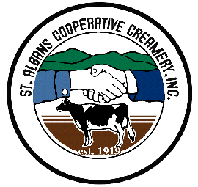 and primary supplier of cream and condensed milk ingredients for over 20 years. The Coop is a member-owned business whose farmers have direct influence over their operations and their profit allocations.
and primary supplier of cream and condensed milk ingredients for over 20 years. The Coop is a member-owned business whose farmers have direct influence over their operations and their profit allocations.
Over two decades, we’ve helped to provide a market for Vermont’s dairy farmers with our milk and cream purchases from the Coop. At the same time, the family farmers in the St. Albans Coop have played a big role in preserving Vermont’s rural heritage and in upholding many of the values we believe in.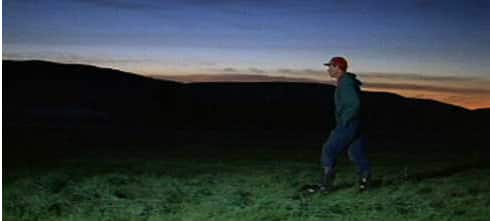
Ben & Jerry’s pays a premium to the farmers of the St. Albans Coop for their pledge not to treat the cows that produce our milk and cream with rBGH, a genetically engineered growth hormone used to increase milk production. We oppose the use of rBGH because we believe it is a step in the wrong direction toward a synthetic, chemically-intensive, factory-produced food supply. All of our ice cream pints contain a statement of our position on rBGH.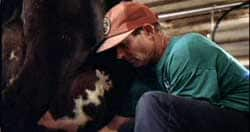
The Coop is our partner in the Dairy Stewardship Alliance, a unique program that helps farmers move toward more sustainable practices on the farm.
Fair Trade Certified Coffee Extract
 All of the coffee extract we use in our coffee flavors is Fair Trade Certified (Coffee, Coffee Heath Bar Crunch, Coffee Coffee Buzz Buzz Buzz). The Fair Trade certification logo on our coffee ice cream pints is a guarantee that the farmers who grow our coffee at Huatusco Cooperative,
All of the coffee extract we use in our coffee flavors is Fair Trade Certified (Coffee, Coffee Heath Bar Crunch, Coffee Coffee Buzz Buzz Buzz). The Fair Trade certification logo on our coffee ice cream pints is a guarantee that the farmers who grow our coffee at Huatusco Cooperative, 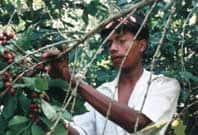 in Veracruz, Mexico are paid a fair price for their harvest; are members of democratically organized cooperatives; and have access to affordable credit. Fair Trade can help farmers earn the means to stay on their land, put food on their table, and keep their children in school. And Fair Trade certification signifies responsible stewardship of the land through environmentally sound farming techniques.
in Veracruz, Mexico are paid a fair price for their harvest; are members of democratically organized cooperatives; and have access to affordable credit. Fair Trade can help farmers earn the means to stay on their land, put food on their table, and keep their children in school. And Fair Trade certification signifies responsible stewardship of the land through environmentally sound farming techniques.
Ben & Jerry’s is glad to be a part of the growing Fair Trade movement around the world, which allows socially conscious consumers to have a positive impact on people and communities in the developing world. To learn more about Fair Trade, visit Transfair USA.
Greyston Bakery Brownies
The brownies in our Chocolate Fudge Brownie and Half Baked  ice creams and frozen yogurts come from the Greyston Bakery in Yonkers, NY, our partner since 1988. The bakery is owned by the Greyston Foundation, a nonprofit with a mission to support low-income people and families on the path to self sufficiency. The foundation manages several businesses and programs
ice creams and frozen yogurts come from the Greyston Bakery in Yonkers, NY, our partner since 1988. The bakery is owned by the Greyston Foundation, a nonprofit with a mission to support low-income people and families on the path to self sufficiency. The foundation manages several businesses and programs  in the Yonkers area that provide housing for the homeless, childcare, employment training, jobs, and comprehensive healthcare for people living with HIV/AIDS. Over 2,000 people are reached by Greyston programs each year.
in the Yonkers area that provide housing for the homeless, childcare, employment training, jobs, and comprehensive healthcare for people living with HIV/AIDS. Over 2,000 people are reached by Greyston programs each year.
 From the start, we’ve paid a premium for Greyston’s great brownies to help the bakery establish itself and to support the implementation of its mission. Along the way, we’ve worked together to reduce this premium as Greyston evolves into a viable, competitive and sustainable business.
From the start, we’ve paid a premium for Greyston’s great brownies to help the bakery establish itself and to support the implementation of its mission. Along the way, we’ve worked together to reduce this premium as Greyston evolves into a viable, competitive and sustainable business.
Sustainably Grown Vanilla
 Since 2002, when we launched “Vanilla for a Change,” we’ve gone out of our way to source the vanilla extract in our smooth Vanilla ice cream from cooperatives of farmers who practice sustainable techniques on small-scale farms. In 2006, we used extract from a blend of vanilla beans, the majority of which were grown and harvested by small-scale producers in North Sumatra, Lampung, and Bali, Indonesia. These vanilla growers are members of local associations that encourage soil conservation, shade growing, fertility management, and non-chemical treatment of crops.
Since 2002, when we launched “Vanilla for a Change,” we’ve gone out of our way to source the vanilla extract in our smooth Vanilla ice cream from cooperatives of farmers who practice sustainable techniques on small-scale farms. In 2006, we used extract from a blend of vanilla beans, the majority of which were grown and harvested by small-scale producers in North Sumatra, Lampung, and Bali, Indonesia. These vanilla growers are members of local associations that encourage soil conservation, shade growing, fertility management, and non-chemical treatment of crops.
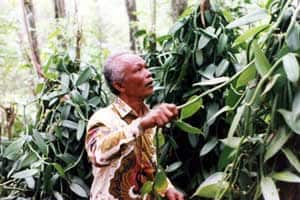 Vanilla produced this way costs more, but we think it’s worth it. Most of the premium we pay for these beans goes directly to farmers. With increased incomes, vanilla growers are able to stay on their land, support their families, and improve their communities.
Vanilla produced this way costs more, but we think it’s worth it. Most of the premium we pay for these beans goes directly to farmers. With increased incomes, vanilla growers are able to stay on their land, support their families, and improve their communities.
In 2006, Ben & Jerry’s made the decision to seek out Fair Trade Certified vanilla for this flavor, in part to send a clearer, more recognizable message to our consumers about our commitment to responsible sourcing. After the Fairtrade Labelling Organization (FLO) completed its due diligence, a handful of vanilla growers’ associations in Asia and Africa were certified as meeting Fair Trade standards — including some of the Indonesian associations who have supplied us in the past. 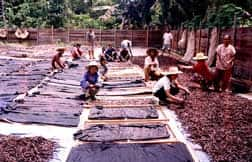 We will begin purchasing extract from Fair Trade Certified vanilla beans for use in our smooth Vanilla ice cream in the U.S. in 2007. (The Vanilla ice cream that Ben & Jerry’s makes in Europe transitioned to Fair Trade Certified in the summer of 2006).
We will begin purchasing extract from Fair Trade Certified vanilla beans for use in our smooth Vanilla ice cream in the U.S. in 2007. (The Vanilla ice cream that Ben & Jerry’s makes in Europe transitioned to Fair Trade Certified in the summer of 2006).
Ben & Jerry’s is pleased to have been a catalyst for the extension of Fair Trade Certification to vanilla and we’re excited that we are one of the first companies in the world purchasing vanilla on Fair Trade terms.
In the bigger picture, we’re proud to be a part of the growing Fair Trade movement, which allows socially conscious consumers to have a positive impact on people and communities in the developing world.
To learn more about Fair Trade, visit our friends at Transfair USA.
Cocoa Powder
Since 2002, when we unveiled “Chocolate for a Change,” we’ve made a special effort to source the cocoa powder used in our smooth Chocolate ice cream from cooperatives of small-scale farmers who are committed to fair labor practices and sustainable techniques.  We pay a premium for this cocoa powder, but we think it’s worth it.
We pay a premium for this cocoa powder, but we think it’s worth it.
In 2006, we sourced this cocoa powder from Kuapa Kokoo, a democratically-run growers’ cooperative in Ghana, West Africa. Part of the coop’s mission is to empower women members to participate in the association’s decision-making process. Kuapa Kokoo’s social practices and environmental standards are certified by the Fairtrade Labeling Organization (FLO), confirming, among other criteria, that forced child labor and trafficking are prohibited and that farmers receive a fair price for their crop.
We also made the decision in 2006 to purchase the cocoa powder for this flavor on Fair Trade terms in 2007, which means we can display the Fair Trade Certified logo on our pints. With this decision, we’re aligning more of our sourcing with the growing Fair Trade movement, which allows socially conscious consumers to have a positive impact on people and communities in the developing world.
To learn more about Fair Trade, visit our friends at Transfair USA.
Superior Peanut Butter
Superior Nut, a small, family-owned enterprise, produces the peanut butter products we use in flavors such as Chubby Hubby, Peanut Butter Cup, and Chocolate Peanut Butter Swirl.  As a 100% carbon neutral business, Superior Nut offsets all of the carbon dioxide (CO2) emissions associated with their U.S. processing plant and vehicle travel.
As a 100% carbon neutral business, Superior Nut offsets all of the carbon dioxide (CO2) emissions associated with their U.S. processing plant and vehicle travel.
Since 1997, Superior Nut has managed its offsets through a unique partnership with the nonprofit organization, Reforest the Tropics, which supports reforestation efforts in Costa Rica. As the major supporter of RTT, Superior Nut has sponsored the planting of over 50 acres of carbon-offset forests to date. These forests also provide income to the Costa Rican farmers who harvest selected trees as a necessary part of sustainable forest management.
We’re happy to support this innovative work that addresses the challenge of global warming and supports reforestation efforts through our purchases of peanut products from Superior Nut.
Strawberries
Ben & Jerry’s Strawberry ice cream is made with puree from a blend of  strawberries grown on two farms that are leading the way towards environmentally sustainable agricultural practices.
strawberries grown on two farms that are leading the way towards environmentally sustainable agricultural practices.
Stahlbush Island Farms in Corvallis, Oregon is working to protect their groundwater and farmlands through the use of sustainable farming techniques, including integrated pest management, farm nutrient management, and wildlife conservation initiatives.
Mike & Jean’s Berry Farm in Skagit County, Washington also has a great track record of sustainable practices and a strong commitment to progressive labor practices, providing their seasonal workers with housing, daycare, and space for kitchen gardens.
We buy our strawberries from these farms to support their staunch commitment to better environmental and social practices. In 2006, we produced this flavor only for our Scoop Shops.
Certified Humane Cage Free Eggs
In 2006, we made the decision to transition all of the eggs used in our U.S. ice cream production to Certified Humane cage-free suppliers over a four-year period, beginning in 2007. This decision makes Ben & Jerry’s one of the first national food manufacturers to commit to using Certified Humane cage-free eggs. We’ll begin a gradual transition in 2007 and have our egg supply coming entirely from Certified Humane cage-free hens by the end of 2010.
The Certified Humane designation means that egg-laying hens are guaranteed to have wholesome, nutritious food, access to clean water, and adequate space to engage in normal behaviors, among dozens of criteria crafted by veterinary professionals. Compliance with these standards is provided by the nonprofit organization Humane Farm Animal Care in Herndon, Virginia.
We have been sourcing free-range eggs (‘vrije uitloop’) for our European production since 2004, and we had a U.S. transition to cage-free eggs in mind for some time. However, supply and cost challenges had been insurmountable until this year. The constructive engagement of the Humane Society of the United States over a period of several months was also helpful in moving us forward on this issue. The phase-in period was necessary to allow Ben & Jerry’s to absorb the additional cost of cage-free eggs and to give the cage-free industry time to expand supply to meet our volume requirements.
SCOOP SHOPS
Bringing Ice Cream to the People
Ben & Jerry’s began as a single ice cream Scoop Shop in 1978, and though our business has taken plenty of twists, turns, and swirls along the way, we’re  in the Scoop Shop business more than ever before. In fact, we had over 436 shops scattered across the U.S. and Canada by the end of 2006. Most are owned and operated by independent franchisees, although Ben & Jerry’s also manages 10 company-owned stores in Vermont, New York City, and Las Vegas; and 18 of our stores (including Northern Ireland and Israel) are PartnerShops, owned and operated by nonprofit organizations. Visit Ben & Jerry’s Scoop Shops page on our company website for more information.
in the Scoop Shop business more than ever before. In fact, we had over 436 shops scattered across the U.S. and Canada by the end of 2006. Most are owned and operated by independent franchisees, although Ben & Jerry’s also manages 10 company-owned stores in Vermont, New York City, and Las Vegas; and 18 of our stores (including Northern Ireland and Israel) are PartnerShops, owned and operated by nonprofit organizations. Visit Ben & Jerry’s Scoop Shops page on our company website for more information.
Serving Ice Cream to Serve Humanity
In addition to being gathering places for great ice cream, Scoop Shops are most often centers for Social Mission and activism. So when we take stock every year of how well we in Vermont delivered on our Company values, we also extend our thanks to the dedicated Scoop Shop owners across the country who’ve brought a commitment to social and environmental change into the way they manage business in their communities.
As a Company, we continue to look for ways to activate the company’s Social Mission priorities in our Scoop Shop network. Namely:
Encourage business to give back to the community
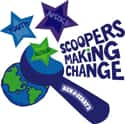 Our franchisees, their scoopers, and folks in our company-owned stores around the world made a difference by fostering positive social change through their local community action efforts in 2007.
Our franchisees, their scoopers, and folks in our company-owned stores around the world made a difference by fostering positive social change through their local community action efforts in 2007.
Through Scoopers Making Change, a grant program for Ben & Jerry’s scoop shop employees, we encourage greater activism through our business. In 2007 we offered grants to four scoop shop employees to support their plans to improve their communities.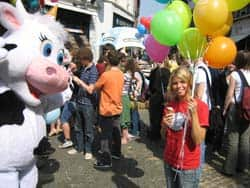
As always, we celebrated the anniversary of Ben & Jerry’s 1978 debut with Free Cone Day. This year’s worldwide event was our biggest yet, and we helped raise money for hundreds of partner nonprofits around the globe at the same time.
Help youth build better futures
Our Scoop Shops are great venues to provide youth who may face  barriers to employment a place and a chance to gain critical job and life skills. That’s why we invented the PartnerShop model years ago, in which a Ben & Jerry’s Scoop Shop is owned and operated by a youth-focused nonprofit organization. We remain committed to seeing these mission-focused Scoop Shops succeed.
barriers to employment a place and a chance to gain critical job and life skills. That’s why we invented the PartnerShop model years ago, in which a Ben & Jerry’s Scoop Shop is owned and operated by a youth-focused nonprofit organization. We remain committed to seeing these mission-focused Scoop Shops succeed.
We also continued our Cones to Careers program in 2006, a program that provides youth who face barriers to employment with job skills and hands-on work experience through internships in our company operated stores.
our Cones to Careers program in 2006, a program that provides youth who face barriers to employment with job skills and hands-on work experience through internships in our company operated stores.
Build sustainable business practices
Activating the Company’s core values throughout the franchise community is a key to our success. We know we’ve got to get better at setting targets and measuring our progress in this area. One statistic that we track annually is franchise ownership diversity.
When franchisees build new Ben & Jerry’s Scoop Shops, we continue to 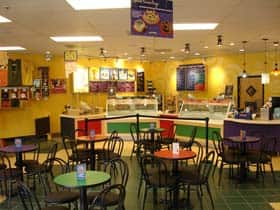 look for opportunities to source and specify materials and items that meet national standards for building green — while also meeting our build-out cost targets and the demands of the food service industry. Current materials successfully accomplishing this goal include “green” flooring, solid-surface counters, lighting, refrigerants, and paint.
look for opportunities to source and specify materials and items that meet national standards for building green — while also meeting our build-out cost targets and the demands of the food service industry. Current materials successfully accomplishing this goal include “green” flooring, solid-surface counters, lighting, refrigerants, and paint.
Not the Only Cone in Town
In 2006, competition in the marketplace was unprecedented, with the total number of ice cream stores of all brands growing rapidly over the last two years. Clearly some markets where we operate have reached saturation. And while our customers did spend more money per transaction at our Scoop Shops in 2006 (average transaction increased 12%), we lost customers to the “new kids on the block.” With transaction counts down and sales per transactions up, we ended the year virtually flat.
Faced with this intense competition and still sporting tender wounds from the growing pains of 2005, we took a measured and conservative position in order to come out on top in 2006. The good news is that we accomplished most of what we set out to do.
The supply chain difficulties that led to under-fills, shortages and compromised product quality were rectified and franchisees were compensated with more than $120,000 for their losses. With new quality assurance processes in place we were able to deliver quality product, on time, in 2006.
In order to help us weather the storm in the over-crowded ice cream marketplace, we scaled back our new store development goals and got even more rigorous when approving new locations for Scoop Shops.
With a new Design and Build Manager on board in 2006, we were able to reduce the costs of building a new Scoop Shop by 30%, on average, while still incorporating a variety of “green” building materials (such as eco-friendly flooring products, non-toxic paints, and energy-efficient lighting). We will continue to evaluate our suppliers and materials to bring even greater cost savings to franchisees.
We dug our heels in and made some much needed improvements to our Scoop Shops’ computerized cash register system, reducing costs and improving performance for our franchisees. We’ve still got kinks to work out, but we’re moving in the right direction after two difficult years.
While we were hard at work to make good on our promises and make up for some of our shortcomings in 2005, a US-based columnist wrote an article in the United Kingdom-based Ethical Corporation magazine critical of several aspects of our franchise program over recent years, but perhaps most critical of the context in which we report our earnings information in our franchise legal circular. The writer suggests more earnings detail should be provided within the document. We maintain that by providing numbers that include the lowest sales, highest sales, average sales and median sales of the Scoop Shop system, it illustrates the complete sales range of the system. We also pointed out that the document notes that Scoop Shop sales vary widely and that potential franchisees will gain a better understanding of sales variability by interviewing an existing franchisee operating a Scoop Shop in a comparable location type.
While in our opinion the article does not fairly represent our practices or reflect our commitment to our franchisees, this experience moved us to reexamine what and how we communicate with our franchisees and the public in general. Going forward, we’ve challenged ourselves to be as precise and transparent as we can possibly be in all of our communications with prospective franchisees, the public, and our franchise community.
We look forward to working closely with our Franchise Advisory Council to improve economic performance and the overall health of our franchise community. And while we still have work to do, we made some progress and feel we are well positioned for the future.
The PartnerShop Program
 PartnerShops are Ben & Jerry’s Scoop Shops that are owned and operated by youth-serving nonprofit organizations. Ben & Jerry’s waives the traditional franchise and royalty fees for PartnerShops and provides customized training to support the unique needs of these social enterprises. In turn, PartnerShops offer youth facing barriers to employment a unique opportunity for developing job skills. All proceeds from PartnerShops flow back to the parent nonprofit to support social programs.
PartnerShops are Ben & Jerry’s Scoop Shops that are owned and operated by youth-serving nonprofit organizations. Ben & Jerry’s waives the traditional franchise and royalty fees for PartnerShops and provides customized training to support the unique needs of these social enterprises. In turn, PartnerShops offer youth facing barriers to employment a unique opportunity for developing job skills. All proceeds from PartnerShops flow back to the parent nonprofit to support social programs. 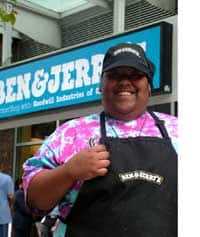 Read all the most up-to-date information about our PartnerShop operators on our website.
Read all the most up-to-date information about our PartnerShop operators on our website.
We started 2006 with the following PartnerShop Operators:
- Cresco Trust — Derry and Belfast, Northern Ireland
- Friends of Youth — Seattle, WA
- Goodwill Industries of Greater Detroit — Detroit, MI
- Juma Ventures — San Francisco and Oakland, CA
- Metro Community Investment — Minneapolis, MN
- Latin American Youth Center — Washington, DC
- Life’s Work of Western PA — Pittsburgh, PA
- Lifeworks — Austin, TX
- New Avenues for Youth — Portland, OR
- Second Chance — San Diego, CA
- YWCA of Ft. Worth and Tarrant County — Ft. Worth, TX
Three new organizations joined our PartnerShop Community in 2006:
- Goodwill Industries of the Southern Rivers — Columbus, GA
- Houston Works — Houston, TX
- Aberdeen Foyer — Aberdeen, Scotland
Due to challenging political and economic conditions, the pilot PartnerShop in Sderot, Israel closed in September 2006.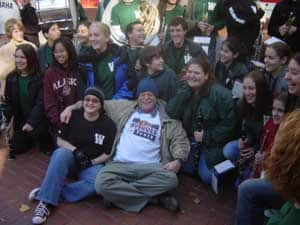
At the end of 2006, there were a total of 17 PartnerShops in operation in the U.S., Northern Ireland and Scotland.
We had some notable successes in our PartnerShop Community in 2006:
- 310 youth were trained in job and life skills in our PartnerShops.
- 101 of these youth moved on to higher paying jobs, higher education, or vocational training.
- Average sales per transaction increased on average for our PartnerShop community by $0.83 while the overall average sales per transaction amounted to $6.04, an increase of $1.04 from 2005.
- The average PartnerShop Evaluation Score was 93/100.
- Building on ten years of success in San Francisco’s Candlestick Park (now Monster Park) and AT&T Park, Juma Ventures was awarded a new vendor contract at the Oakland Coliseum and kicked off their operation selling Ben & Jerry’s ice cream to fans at the first Athletics home baseball game in April 2006.
- The New Avenues for Youth PartnerShop in Portland, OR, won the “2006 Heck of a Year” Award at the 2007 Ben & Jerry’s Global Franchise Community Gathering.
- The Lifeworks PartnerShop in Austin, TX, was recognized as one of the “2006 Top Ten Caterers” in the Ben & Jerry’s Franchise Community.
- Ben & Jerry’s teamed up with our Northern Ireland PartnerShop Operator, Cresco Trust, and the International Fund for Ireland in order to create the first ever Global PartnerShop Community Meeting and Inaugural Global Social Enterprise Forum. The Meeting took place September 13-15, 2006, in the city of Derry, Northern Ireland. Meeting participants shared experiences and best practices for enhancing overall PartnerShop performance and strengthening the youth employment training mission.
- The Global Social Enterprise Forum was a transatlantic meeting of “socially spirited minds”, bringing together leading U.S. and UK social entrepreneurs such as Jerry Greenfield, Ben & Jerry’s Co-Founder; Jeff Furman, originator of Ben & Jerry’s PartnerShop model; and Charles Lief from the Hartland Group (former CEO of the Greyston Bakery).
After more than 20 years in the “PartnerShop business” we remain committed to these social enterprises and the notion that business has the power to transform communities and help solve social problems. At the same time, we have seen enough PartnerShops open and close over the years to understand the various risks that accompany these ventures.
In 2006 we slowed down our PartnerShop development program in order to address these risk factors more effectively. Currently we have four designated “open markets” for PartnerShop development: Boston, Atlanta, Miami and L.A. As a result of scaling back our development efforts, we were able to provide more on-going management and training support to our current PartnerShop Operators.
We continue to strive to enhance the PartnerShop business model in order for our PartnerShop operators to be better positioned to meet their financial, operational and job training outcomes. We recognize that the PartnerShop model is challenging given the double bottom line (which seeks profits and social benefits at the same time) that each one balances on a daily basis. In addition, the challenging 2006 market environment for Ben & Jerry’s Scoop Shops impacted the PartnerShop community as well. Some PartnerShops experienced decreasing customer counts and lower sales in 2006, requiring them to scale back their job training efforts in order to keep costs down.
One important shift in the business model in 2006 was the integration of the “PartnerShop Enterprise Director” role into the PartnerShop management structure. The Enterprise Director serves as the “franchisee” and is ultimately responsible for managing the financial, operational and job training outcomes for the PartnerShop. By year’s end, 75 percent of our nonprofit operators had created the Enterprise Director role within their organization, and these operators did see improved outcomes.
We will continue to work in 2007 with our nonprofit operators in order to find ways to reduce the risks wherever possible and produce more positive social and financial outcomes for our PartnerShops.
Cones to Careers
Cones to Careers is a Ben & Jerry’s initiative that provides youth who face barriers to employment with job skills and hands-on work experience through internships in our company-operated Scoop Shops. We partner with nonprofit organizations to ensure that our interns have the pre-employment training they need and on-going support to achieve their goals.
Now in its third year, Cones to Careers is a fixture in our Times Square (NYC) and Burlington  (Vermont) company stores. In 2006, 9 young people successfully completed the internship program in these two stores, meeting our program goal (6-10). Eight of these graduates were offered employment with Ben & Jerry’s after the program.
(Vermont) company stores. In 2006, 9 young people successfully completed the internship program in these two stores, meeting our program goal (6-10). Eight of these graduates were offered employment with Ben & Jerry’s after the program.
Although we set a 2006 goal to launch the program in our Las Vegas company stores, we halted our move west, once plans to sell most of our Vegas locations were announced.
In 2007 we’ll continue to operate the program in Burlington and Times Square and we hope to launch the program in our Waterbury (VT) Scoop Shop and in the newly acquired Chelsea location in NYC. We’d like to train 3 – 4 interns in Times Square and at the Burlington Scoop Shop and 2 – 3 in Waterbury and Chelsea, for a total of 10 – 14.
As called for in our 2006 goals, we are also exploring ways to bring Cones to Careers to our franchised Scoop Shops and to create internship opportunities in other departments (such as tours and manufacturing) within Ben & Jerry’s.
Scoopers Making Change
Scoopers Making Change is a new Ben & Jerry’s program aimed at helping young Scoop Shop employees develop 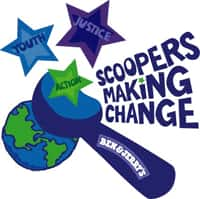 leadership and social activism skills. Our first year of the program was a huge success!
leadership and social activism skills. Our first year of the program was a huge success!
We asked scoopers around the country to send us their ideas for how to promote positive social change in their own communities, and then we brought nine of these scoopers to Vermont for a jam-packed week of work and play. During their stay with us, these activists-in-training developed their ideas, learned community organizing skills, and refined their action plans, working closely with mentors Ben & Jerry’s and our partners. We sent each scooper home with a grant of up to $1,000 from Ben & Jerry’s to help with project implementation.
We’re proud of the 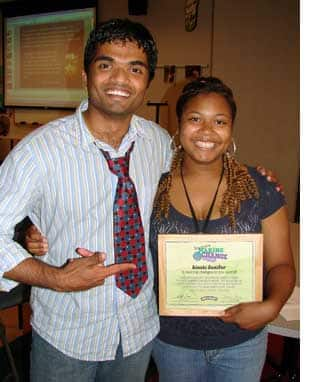 energy and commitment of these young people who tackled important issues facing their communities, including:
energy and commitment of these young people who tackled important issues facing their communities, including:
- Providing school supplies and support to school children from low-income neighborhoods
- Educating high school students about the risks of teen pregnancy
- Connecting homeless people to information and resources in their local community
- Using photography to educate people about HIV and AIDS in the African American community
- Providing free art classes for children attending schools in low income communities that don’t offer art.
The week was a powerful experience for 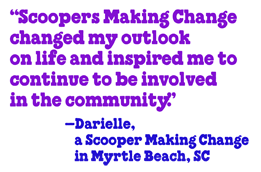 employees in our Central Support office. We were inspired by the passion and dedication of the scoopers to making their communities a better place. It was also affirming for many of our employees to participate directly in activating our company’s Social Mission through this innovative program.
employees in our Central Support office. We were inspired by the passion and dedication of the scoopers to making their communities a better place. It was also affirming for many of our employees to participate directly in activating our company’s Social Mission through this innovative program.
Next July we’ll do it again, and this time we’ll extend an invitation to at least one scooper from the United Kingdom and one from Canada. Other goals for 2007 include:
- Increasing the number of participants from 8 to 12
- Encouraging at least 50% of participants to become active in the Youth Venture network
Maybe we’ll go global in 2008!
We’re grateful for the expertise and support of our friends from Youth Venture and the Vermont-based DREAM Program who have collaborated so closely with us and helped make Scoopers Making Change a pivotal experience for everyone involved. Our gratitude also goes out to the franchisees who 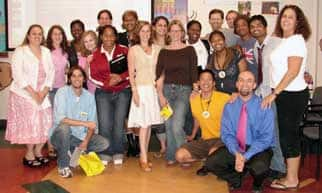 sponsored the participants for our pilot program.
sponsored the participants for our pilot program.
Franchise Ownership Diversity
Our company’s statement of values includes the goal to create economic opportunities for those who have been denied them. We’ve always felt that our franchised Scoop Shops offer us a great opportunity to reach for this goal. While we do not have a formal program to recruit minorities and women to become Ben & Jerry’s franchisees, we have always attempted to create a culture in our franchise community where diversity is celebrated and encouraged.
For the record, here’s our track record on diversity: At the end of 2006, there were 225 distinct owner/operator groups for the 448 independently owned and operated Ben & Jerry’s shops in the United States and Canada. Of these owner/operator groups, 12.8% were led by women and another 18.2% were led jointly by a male/female team. Furthermore, 17.7% of our total owner/operator groups were led by people of color (African-American, Asian, or Hispanic).
Our goals for 2007 include:
- Evaluating and updating our franchise recruitment and discovery process to ensure we are inclusive and reaching out to minorities and women.
- Surveying our franchisees to assess our success at promoting an inclusive and respectful community where diversity is celebrated.
Scoop Shop Community Action
Ben & Jerry’s franchisees take great pride in being part of their community, and virtually all translate our Social Mission into action in their own unique ways. We love to hear about projects far and near, and when we add up all the various community initiatives, including product donations and paid employee time, the sum total of our franchisees’  efforts always boggles our mind. In all, Ben & Jerry’s franchisees directly contributed more than $600,000 worth of time, product, and money in support of local community projects in 2006 — and leveraged even more support for valuable projects around the country through their efforts. We’re thankful for the dedication and creativity of our franchisees when it comes to community action.
efforts always boggles our mind. In all, Ben & Jerry’s franchisees directly contributed more than $600,000 worth of time, product, and money in support of local community projects in 2006 — and leveraged even more support for valuable projects around the country through their efforts. We’re thankful for the dedication and creativity of our franchisees when it comes to community action.
Franchisee Highlights
The full story of our franchisees’ community activities in 2006 would crash your computer, so here are just a few tidbits that caught our attention:
You can’t get a job in Jim Healey’s (Raleigh, NC) Scoop Shops without pledging a commitment to community service. All of Jim’s employees are expected to volunteer in some way. To foster  this service ethic, Jim “adopted” a local after-school program called Kids Café and his goal is to have at least one of his employees volunteering at Kids Café every day. In addition to connecting volunteers with this fantastic after-school program, Jim has donated hundreds of dollars and more than a thousand scoops of ice cream to support the program — and he’s involved in numerous other initiatives, too.
this service ethic, Jim “adopted” a local after-school program called Kids Café and his goal is to have at least one of his employees volunteering at Kids Café every day. In addition to connecting volunteers with this fantastic after-school program, Jim has donated hundreds of dollars and more than a thousand scoops of ice cream to support the program — and he’s involved in numerous other initiatives, too.
Fred vom Lehn (Charleston, SC) doesn’t let his tourist-centered locations keep him from connecting with his neighbors and community. Since 1997, Fred and his team have partnered with his local Red Cross chapter to support their quarterly media blood drives, which are televised live for 12 straight hours. Fred offers a cone to every donor, adding up to more than 3,000 scoops each year. With Fred’s help, the Red Cross has increased the number of participating donors from about 500 per drive to a record 2,000 in 2006!
Judy Tarr (Cape Cod, MA) decided to take action in her community to help stop global warming. She joined a task force to advocate for clean buses on the Cape. Thanks in part to Judy’s hard work and dedication, today visitors can ride low-emissions buses from one tip of the Cape to the other and if they want, they can step off at the Ben & Jerry’s bus stop for a cone! Be sure to show Judy your bus pass to get a 10% discount.
To learn more about the community activities of a Ben & Jerry’s franchisee near you, please use the local store locator on our Company website.
Franchise Community Service Project
Once a year, Ben & Jerry’s franchisees get together at the Annual Franchise Community Gathering to network and share best practices. In true Ben & Jerry’s style, the meeting traditionally kicks off with a community service project in partnership with a local nonprofit organization in the host city.  We’ve rebuilt houses, cleaned beaches, spruced up a community center, and built playgrounds and skate parks in underserved communities over the years.
We’ve rebuilt houses, cleaned beaches, spruced up a community center, and built playgrounds and skate parks in underserved communities over the years.
In 2006 we gathered in sunny San Diego and got straight to work sprucing up The Jackie Robinson YMCA located in one of the poorest neighborhoods of San Diego. Working hand in hand with the staff of the JRYMCA and our friends at Second Chance Strive (our San Diego PartnerShop Operator), we gave a much needed face-lift to an aging facility and several outdoor recreation areas. The JRYMCA is a beacon of hope and a safe and nurturing place for hundreds of children each year. We hope the TLC we shared during our day of work will last and make a real difference for the people of the community. In all, Ben & Jerry’s donated $25,000 and over 2,000 hours of labor to the Jackie Robinson YMCA.
 In January 2007, we could have gathered in a host of sunny vacation spots, but instead decided to hold our annual franchise gathering in the great city of New Orleans. Although technically we should wait until next year’s report to write about it, we had such a great time we couldn’t wait 12 months to share the story! In short, we hoped that bringing our franchisees to New Orleans would play a small part in helping the city as it recovers from Hurricane Katrina. We brought our tourist dollars and, as always, we brought our hammers and nails, too. Franchisees and staff spent a day working with Habitat for Humanity to help rebuild homes in Musician’s Village in the 9th Ward that were destroyed by Katrina. In two great days of work, Ben & Jerry’s donated 2,500 hours of labor to New Orleans Habitat for Humanity, in addition to $30,000 in cash support.
In January 2007, we could have gathered in a host of sunny vacation spots, but instead decided to hold our annual franchise gathering in the great city of New Orleans. Although technically we should wait until next year’s report to write about it, we had such a great time we couldn’t wait 12 months to share the story! In short, we hoped that bringing our franchisees to New Orleans would play a small part in helping the city as it recovers from Hurricane Katrina. We brought our tourist dollars and, as always, we brought our hammers and nails, too. Franchisees and staff spent a day working with Habitat for Humanity to help rebuild homes in Musician’s Village in the 9th Ward that were destroyed by Katrina. In two great days of work, Ben & Jerry’s donated 2,500 hours of labor to New Orleans Habitat for Humanity, in addition to $30,000 in cash support.
Company Store Community Involvement
Our company stores continue to model the spirit of giving back through their community involvement and donations programs. In 2006, company stores in New York, Las Vegas and Vermont contributed more than $36,500 worth of product and staff time in support of over 50 nonprofit agencies.
Here’s just a sample of some of the ways our company stores were involved with their communities in 2006.
- Hosted Christmas is for Kids: Collected more than 1,000 gifts for kids in need
- Sponsored the COTS Walk Burlington to raise money to end homelessness
- Hosted a Vermont Cares fundraising concert every Friday during the Month of May at our Burlington Store
- Conducted a Holiday Coat Drive. Collected over 250 coats
- Donated cakes and ice cream for more than 50 organizations and schools including the Ronald McDonald House, the Salvation Army and the Emergency Food Shelf
- Collected spare change for and promoted the work of KIVA; a nonprofit that supports small business development in poor countries
- Scooped ice cream for 500 volunteers at Green Up Day in Burlington, Vermont
Scooper Bowl
In 2006, Ben & Jerry’s was once again able to send a team of scoopers from our South Burlington office down to Boston to participate in the Scooper Bowl, a gathering of ice cream companies and ice cream lovers joining together for a lot of ice cream in support of a good cause — raising money for cancer research. The Vermont folks teamed up with franchisees in the New England area to scoop thousands of servings of ice cream in all. Although hampered by terrible weather, the event raised $83,450 for the Jimmy Fund and the Dana-Farber Cancer Institute’s children’s programs.
Our Annual Birthday “Thank You!”
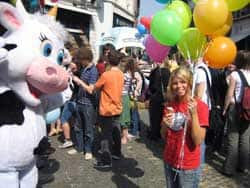 In May of 1979, on the first anniversary of the opening of the original Burlington, Vermont Scoop Shop, Company co-founders Ben Cohen and Jerry Greenfield held their first Free Cone Day, scooping ice cream to all comers to celebrate having survived their first year in business and to say thanks to the community that had made it so. The event was so much fun it became a tradition!
In May of 1979, on the first anniversary of the opening of the original Burlington, Vermont Scoop Shop, Company co-founders Ben Cohen and Jerry Greenfield held their first Free Cone Day, scooping ice cream to all comers to celebrate having survived their first year in business and to say thanks to the community that had made it so. The event was so much fun it became a tradition!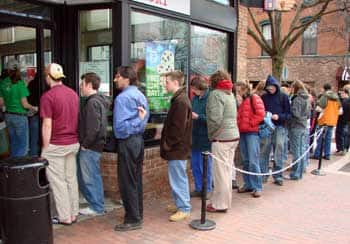
In good faith, we’ve never missed a year. On April 25, 2005, for the 28th consecutive year, Scoop Shops around the globe spread joy for the belly and soul in celebration of Free Cone Day. In all, the global event served up some 1.4 million free scoops to customers in 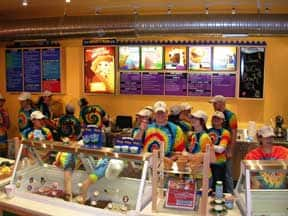 15 countries and raised over $272,000 for hundreds of local community partner organizations. We’ll plan to do it all again next April and we hope to see you there!
15 countries and raised over $272,000 for hundreds of local community partner organizations. We’ll plan to do it all again next April and we hope to see you there!
ENVIRONMENT
Managing Our Impacts
Since 1992 when Ben & Jerry’s signed the CERES principles, we have honored a commitment to support safe and sustainable 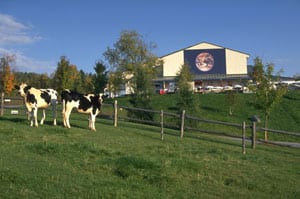 food production and minimize our negative impact on the environment. It’s important for us to continually integrate programs and practices that assure our product and operations stay consistent with our stated agricultural and environmental values.
food production and minimize our negative impact on the environment. It’s important for us to continually integrate programs and practices that assure our product and operations stay consistent with our stated agricultural and environmental values.
Since 2001, we have been pursuing programs that promote sustainable agriculture practices among dairy farmers. The Dairy Stewardship Alliance in Vermont and Caring Dairy, in the Netherlands are collaborative initiatives that help farmers as they pursue leading-edge practices.
As to the impact of our business on the environment, we’re active in a number of areas. We have continued to evaluate and develop the most environmentally progressive packaging available. In 2007 we continued our commitment to reduce our climate impacts around the world by pursuing increased energy efficiency in our supply chain, manufacturing plants, refrigeration systems, and product distribution systems. We continue to purchase carbon offsets as a part of our overall strategy to manage our climate impacts. We also calculated our Global Warming Social Footprint in the US and our Climate Hoofprint in the EU to help us measure whether we’re doing enough to respond to climate change.
Our Environmental Management System commits our manufacturing plants to establishing goals for measuring and reducing other environmental impacts. These areas include energy use and emissions, water use and wastewater management, solid waste and recycling, hazardous waste and high strength dairy waste. The plants establish annual reduction targets, maintain strict adherence to environmental regulations and complete environmental projects sponsored by our company Green Teams for both internal and community-based awareness and education.
Over the years, Ben & Jerry’s has developed and implemented various environmental initiatives. See our timeline to get the complete history of our program.
Towards Sustainable Agriculture
When you think about it, Ben & Jerry’s simply would not be Ben & Jerry’s if it weren’t for the family farms supplying the high quality dairy ingredients we depend on. That’s why we have long been committed to supporting sustainable practices in the dairy industry.
It’s our belief that sustainable agriculture is about making continuous improvements to existing farming practices in order to help make them more environmentally sound, socially just and economically viable. Our commitment to this ideal has taken on various forms over the years. In 2006, we continued our involvement in two ongoing projects in this area, one in Vermont and one in the Netherlands, where Ben & Jerry’s ice cream is manufactured for the European market.
Dairy Stewardship Alliance (Vermont, USA)
The Dairy Stewardship Alliance (DSA) has been a collaborative effort between Ben & Jerry’s, the University of Vermont’s Center for Sustainable Agriculture, the 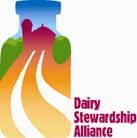 St. Albans Cooperative Creamery and the State of Vermont Agency of Agriculture since 2003. The goals of the DSA are to:
St. Albans Cooperative Creamery and the State of Vermont Agency of Agriculture since 2003. The goals of the DSA are to:
- Provide an on-farm self-assessment tool designed to enable farmers to more efficiently assess the social, environmental and economic aspects of their farm operations.
- Provide information to farmers about sustainable dairy farming practices.
- Provide a foundation for further development of programs that promote sustainable practices.
As a first step in 2003, we engaged four graduate students from the Corporate Environmental Management Program at the University of Michigan’s School of Natural Resources and Environment to develop a comprehensive set of sustainability indicators for dairy farming, along with a set of Educational Modules that farmers could use to self-assess their farm management practices and performance over time.
The Toolkit was officially launched in late 2004 with a group of farmer-members of the St. Albans Coop who provided feedback on the original toolkit as they completed the assessment modules. Their results were submitted for inclusion in a confidential database. Participating farmers received a personalized summary of the results for their farms, a comparison to other member farms’ results, and information on how to improve results.
In early 2006 the DSA was awarded an $87,000 grant from the U.S. Department of Agriculture’s Sustainable Agriculture Research and Education program. This substantial grant will allow the toolkit to be transformed into an interactive online resource. We intend to complete this work by the end of 2007.
To date the DSA has 25 participating farms with a goal of 52 by the end of 2008. Currently more than half of this group have finished the toolkit, identified two specific areas to improve on, and committed to make these changes. Once these changes have been completed each farmer will reassess their operation and determine if their overall score has changed. Going forward, we will continue to work with these farmers to encourage other changes that will have positive impacts on their farm. We also intend to compile quantifiable data on farmers’ progress towards identifying and completing changes on their farms.
In 2006, the Dairy Stewardship Alliance formed an Advisory team made up representatives from the core organizations plus three dairy farmers, a loan officer from the Farm Credit Union and a representative from the Vermont Sustainable Jobs Fund. This team will help with strategic oversight, practical advice, and communication about DSA.

Read The Dairy Stewardship Alliance Toolkit in full: (downloadable PDF files)
- Introduction
- Animal Husbandry
- Biodiversity
- Community Health
- Energy
- Farm Financials
- Nutrient Management
- Organic
- Pest Management
- Soil Health
- Water Management
- Credits/Contacts
As an outgrowth of the DSA, and in response to the rising cost of energy on Vermont dairy farms and growing concerns about climate change, Ben & Jerry’s partnered with the Vermont Environmental Consortium and the 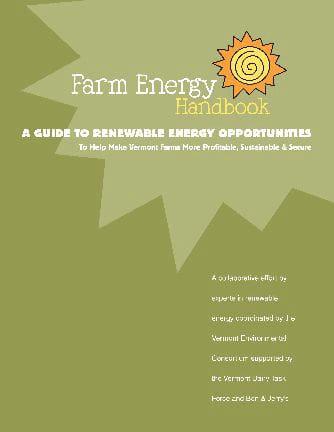 Vermont Dairy Task Force to develop The Farm Energy Handbook, A Guide to Renewable Energy Opportunities in 2006.
Vermont Dairy Task Force to develop The Farm Energy Handbook, A Guide to Renewable Energy Opportunities in 2006.
The goal of the project was to provide dairy farmers access to information that can help them evaluate renewable energy options for their farm. The guide, compiled by experts in fourteen specific areas of renewable energy, provides insight to farmers on questions they would ask in order to make early-phase decisions about which energy products are most applicable to their farm and where to get further information. In 2006 the Farm Energy Handbook was sent to every dairy farmer in Vermont and in early 2007 it was introduced to the Vermont Legislature during their focus on Vermont’s energy future.
In Europe, we are involved in a partnership with our dairy supplier and other groups with the goal to advance sustainable practices in the dairy industry.
EVERYTHING ABOUT ENERGY USE & AIR EMISSIONS
The various components of Ben & Jerry’s manufacturing process use three different forms of energy inputs: electricity, fuel oil, and natural gas. We measure and track the energy use at our plants as well as the resulting CO2 emissions.
Energy Statement
Scientists began to recognize in the early 1960s that an increase in greenhouse gases would make the earth warmer. These gases, which include carbon dioxide, methane, nitrous oxide and other man-made chemicals, are the primary culprits. While each of these gases has significant environmental impacts, carbon dioxide is the most prevalent in the atmosphere. Industry accounts for approximately one-third of all carbon dioxide emissions.
Ben & Jerry’s is committed to reducing our emissions and we have been working toward a 10% reduction in carbon dioxide from our manufacturing facilities by 2007 over 2002 levels. Check out our progress.
To achieve this goal we developed five key areas of focus to reduce our energy consumption and to strive toward technological advances to reduce greenhouse gas emissions.
- We will evaluate our refrigeration systems for maximum efficiency.
- We will seek assistance from outside sources including Efficiency Vermont to identify energy efficiency opportunities.
- We will expand our current energy tracking system to include a calculation of greenhouse gas emissions.
- We will evaluate alternative energy options.
- We will provide extensive educational information to our employees, customers and suppliers regarding actions everyone can take to reduce greenhouse gas emissions.
Through our own initiatives and other industry efforts, Ben & Jerry’s believes that we can achieve a measurable reduction of greenhouse gas emissions.
Energy Use
The energy sources for our Waterbury plant include fuel oil and electricity from Green Mountain Power. The St. Albans plant utilizes natural gas and electricity from Central Vermont Public Service Company. Both GMP and CVPS purchase most of their electricity from nuclear and hydroelectric generating plants, which are low CO2 emitting sources. However, there are other environmental issues associated with our energy sources. Ben & Jerry’s manufacturing plants measure all fuel used and the associated CO2 emissions.
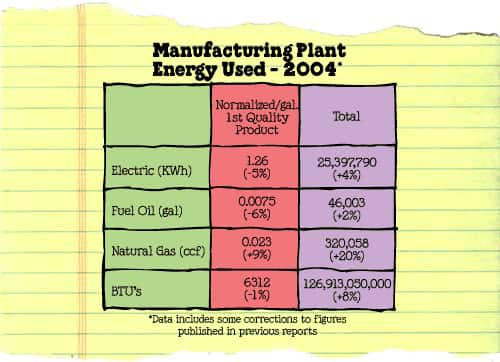
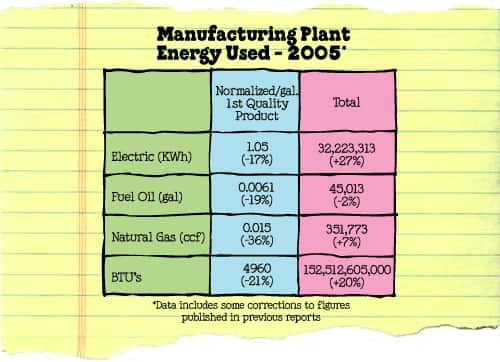
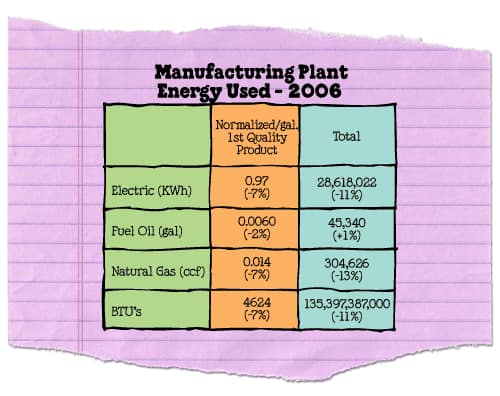
Examples of 2006 Energy Saving Projects:
- New air dryer systems reduced approximately 148,000 kWh of electricity and 10 tons of C02 annually
- New ventilation system will reduce approximately 87,000 kWh of electricity and 6 tons of C02 annually
- New aeration system for wastewater tanks will save approximately 70,000 kWh of electricity and 5 tons of C02 annually
- Updated aeration for the wastewater lagoons saves almost 50,000 kWh of electricity and 3 tons of C02 emissions annually
- We re-lamped the Waterbury plant with higher-efficiency T-5 bulbs and ballasts. The replaced T-8 bulbs and ballasts were donated to local schools.
These projects, in addition to changes made in past years, have resulted in significant energy savings and C02 emissions reductions.
Greenhouse Gas Emissions
In 2002, to proactively address the impact of our business on global climate change, Ben & Jerry’s set a goal to reduce our carbon dioxide (CO2) emissions from our manufacturing process by 10% over 5 years. The end of 2006 marked the end of this five year period, and our data indicate that we successfully met our goal.
Collecting the relevant data to track our progress was not as simple as it might seem. For example, subsequent to setting the goal, we closed our Springfield manufacturing site and Distribution Center. We also began co-packing Good Humor-Breyers ice cream in our St. Albans, Vermont facility and moved production of Ben & Jerry’s novelties out of Vermont to Unilever plants elsewhere. These changes complicated our efforts to measure against a baseline, but we were still able to reliably evaluate CO2 reductions by plant.
2006 CO2 emissions
In evaluating our CO2 emissions to meet our 2007 goals, we looked at the data in two different formats: normalized (CO2 emissions per gallon of product) and absolute (total tons of CO2 emissions).
On a normalized basis, by the end of 2006, we had reduced our CO2 emissions by 32% below 2002 levels. We recognize that our production volume was up almost 50% over the same period, so clearly efficiencies in our production process helped us reach and surpass our 10% reduction goal.
On an absolute basis, our Company’s CO2 emissions increased only 2% from 2002-2006. Clearly our energy saving initiatives over the past several years had a positive effect.
Check out a few examples of changes we made in 2006 to reduce energy use and CO2 emissions.
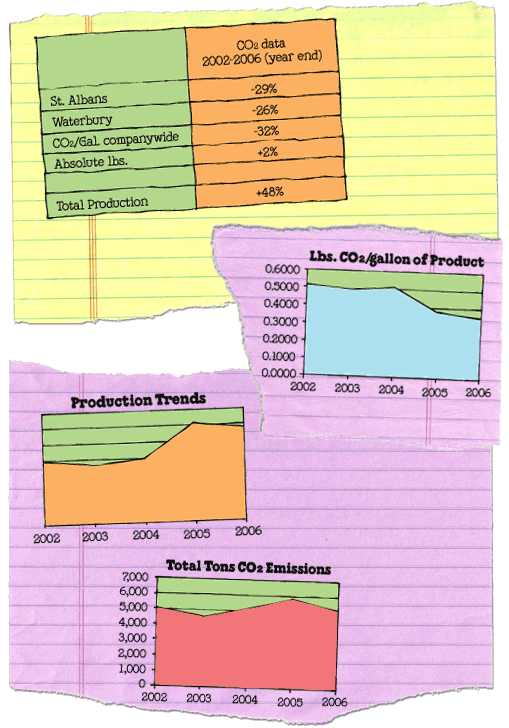
In addition to our emissions reduction efforts, we have also continued to purchase “green tags” from NativeEnergy to offset 100% of our CO2 emissions from our manufacturing sites.
NativeEnergy & Green Tags
A CO2 offset (also referred to as a green tag or carbon credit) is an environmental component of renewable energy. Energy is energy regardless of the source, but when there is a renewable component to it (such as wind, biogas, solar or hydro) there is a secondary value — the environmental benefit. Ben & Jerry’s purchase of these environmental attributes helps fund new renewable energy projects, and we use the clean energy environmental benefits to compensate — “offset” — the CO2 pollution from our energy sources that don’t come from renewable energy.
Working with NativeEnergy, Ben & Jerry’s continues to invest in the Rosebud St. Francis wind turbine project in South Dakota. The project represents phase two of the Tribe’s wind development initiative. In 2002 and 2003, our offsets purchases helped build the phase one Rosebud Single Turbine Project, a single 750 kW NEG-Micon turbine. Through our offset purchase we were able to help NativeEnergy pay approximately 25% of the cost of the turbine for the Rosebud St. Francis tribe, making a necessary and very significant contribution to its financing and development.
In 2006, Ben & Jerry’s offset 5,160tons of CO2 emissions with NativeEnergy. This is equivalent to eliminating over 10 million car miles, driving around the world 415 times, or removing 860 cars from the road for a year! It’s also the fifth year in a row that Ben & Jerry’s has offset 100% of the carbon emissions from our manufacturing operations and employee air travel.
Distribution & Transportation
Vermont’s Finest, located in Waterbury, VT continues to operate seven trucks for sales 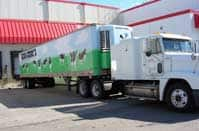 and distribution purposes throughout the state. These trucks distribute both Good Humor-Breyers and Ben & Jerry’s products. The purpose of the Plant Shuttles is to move ingredients between the two manufacturing sites. Emissions associated with these uses are outlined below.
and distribution purposes throughout the state. These trucks distribute both Good Humor-Breyers and Ben & Jerry’s products. The purpose of the Plant Shuttles is to move ingredients between the two manufacturing sites. Emissions associated with these uses are outlined below.
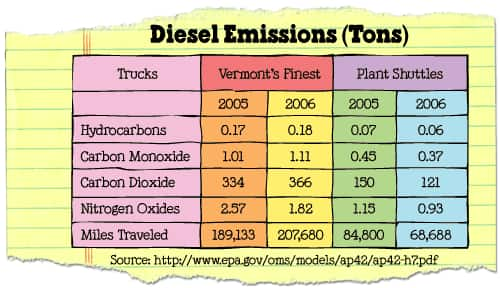
In 2006 we updated the emissions calculations to reflect more current sources of data that calculate emissions from diesel trucks. See www.epa.gov.
Global Warming Social Footprint
We have been working to reduce the global warming-causing greenhouse gas emissions that result from making Ben & Jerry’s ice cream for several years. Our efforts have included improving efficiencies, investigating the practicality of renewable energy, and offsetting all of the carbon emissions from our manufacturing operations.
But we haven’t been able to answer one very important question about our company’s response to global warming: Exactly how much should we be reducing our greenhouse gas emissions each year?
In 2006, Ben & Jerry’s began a focused effort to answer this huge question. It’s an important question because in order to successfully meet the challenge of global warming as a world community, we need a plan that will share the burden of reducing greenhouse gases in the atmosphere equitably among regions, nations, industries, and individuals.
We don’t have such a plan yet in the United States, where carbon dioxide, the most significant greenhouse gas, is not regulated by the federal government. (We’re pushing Congress to fix that through our Lick Global Warming Campaign.
So we looked to a plan that some of the best climate scientists in the world have proposed called the WRE350 Plan. It spells out annual limits on the amount of carbon (in the form of carbon dioxide) humans can emit globally over the next 150 years in order to stabilize the concentration of carbon dioxide in the atmosphere at a safe level of 350 parts per million. (A number of other proposed plans aim for higher levels of atmospheric carbon dioxide, ranging from 450 to 750 parts per million. We chose the most aggressive plan, which we think represents the best response to global warming.)
Then, in consultation with the Center for Sustainable Innovation, we used a new analytical technique, the Global Warming Social Footprint, to figure out what the WRE350 Plan meant for Ben & Jerry’s. The purpose of the project was to identify an annual level of carbon emissions that our Company’s manufacturing operations could emit (in the form of carbon dioxide) that would represent our proportionate share of the WRE350 Plan.
It is our belief that if every business calculated a Global Warming Social Footprint and developed aggressive plans to meet its annual emissions targets, then our planet would have the ability to safely assimilate human-produced carbon emissions, resulting in stable levels of atmospheric carbon dioxide by 2150. While a lofty goal, we need to start someplace.
The results of our project indicated that our investments in energy efficiency and carbon offsets over the past several years have reduced our global warming footprint, but not quite as fast as the WRE350 Plan requires. Ben & Jerry’s manufacturing plants emitted 6,279 net tons of carbon in the form of carbon dioxide over the six years from 2001-2006, which is just 133 tons more carbon than our share of the WRE350 Plan allows. We therefore missed our cumulative WRE350 target by 2.2 % during the years from 2001-2006. (Our performance did meet the requirements of the less aggressive WRE450 plan, which many policy makers and businesses have embraced.)
In order for Ben & Jerry’s to achieve our WRE350 target, we’ll need to make further efficiency gains, switch to lower or no carbon energy sources, or purchase more carbon offsets.
In 2007, we’ll take what we’ve learned from this Global Warming Social Footprint and use it in developing a specific climate change plan.
Learn more about the Social Footprint methodology and our partners at the Center for Sustainable Innovation.
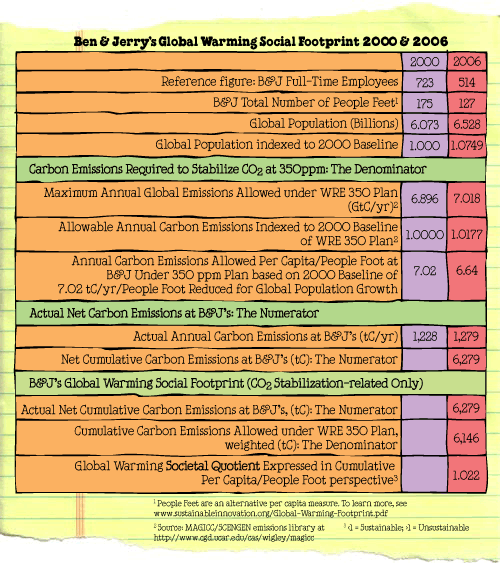
PACKAGING
Farewell to the Eco-Pint
 After nine years, we said goodbye to the Eco–Pint, the unbleached paperboard pint container used to package our ice cream. We had hoped that other food companies would join us in moving toward unbleached paperboard packaging, an environmentally friendly material that does not require the use of chlorine bleach. But since the market for this kind of packaging never grew much beyond Ben & Jerry’s, we ran into increasing supply, quality, and cost challenges.
After nine years, we said goodbye to the Eco–Pint, the unbleached paperboard pint container used to package our ice cream. We had hoped that other food companies would join us in moving toward unbleached paperboard packaging, an environmentally friendly material that does not require the use of chlorine bleach. But since the market for this kind of packaging never grew much beyond Ben & Jerry’s, we ran into increasing supply, quality, and cost challenges.
In the fall of 2006, we transitioned to a pint container made out of a bleached paperboard that is more readily available and that has superior forming characteristics. Our new supplier has an excellent track record of sustainable forestry practices and can help us achieve our long-held goal of finding a non-petroleum based, renewable coating for our pint package. The move away from the Eco-Pint will also allow us to eliminate approximately 1,000 tons of waste annually from our packaging supply chain.
We feel this is a necessary step sideways so we can keep moving forward on our journey to reduce the environmental impacts of the packaging we use for our pints. 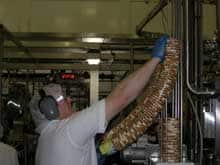 While it moves us farther away from the goal of eliminating chlorine in the manufacturing process of our pint container, it moves us closer to several other goals: sourcing paperboard that comes from sustainably harvested wood; achieving a renewable, non-petroleum based coating for our packaging; and reducing waste.
While it moves us farther away from the goal of eliminating chlorine in the manufacturing process of our pint container, it moves us closer to several other goals: sourcing paperboard that comes from sustainably harvested wood; achieving a renewable, non-petroleum based coating for our packaging; and reducing waste.
Our packaging team continues to actively evaluate alternative, renewable resins to replace polyethylene on the pint container. Our preliminary results have been favorable, though we have some technical challenges yet to overcome.
Scoop Shop Packaging
The packaging used in Ben & Jerry’s Scoop Shops includes a wide variety of cold drink cups and various ice cream bowl sizes as well as spoons, straws, napkins and lids. Where we have been able to make substitutions for more environmentally sound choices, we’ve made the changes. That has been the case with our polyethylene cups and paper napkins made from 100% unbleached, recycled content. However, our ultimate goal is to find a 100% renewable material for all of our Scoop Shop packaging.
In 2006, we made great progress on our project to locate cold drink cups manufactured from renewable resins. In partnership with our supplier, we will transition our drink cup line to green-ware that uses a renewable corn-based resin in early 2007.
In 2006, we also continued our efforts to reduce our use of bleached paper by transitioning to the use of non-bleached paper for our cake and cookie packaging. Of course the best environmental effort we can make is to reduce the amount of packaging we use in general!
ENVIRONMENTAL MANAGEMENT
Beginning in 2002, Ben & Jerry’s manufacturing sites initiated the development of an environmental management system that followed Unilever’s framework standards. These framework standards closely parallel the ISO14001 management system and have proven to be a useful strategy by providing a single resource for all plant-related environmental information. Specifically, the framework standards are important for identifying training needs and ensuring regulatory compliance. At the beginning of each year, their content is reviewed by Ben & Jerry’s Environmental Coordinators and the Manager of Natural Resources. The standards are then maintained by the Environmental Coordinators and are updated on a regular basis as needed.
Unilever completes an annual Environmental Performance Review (EPR), also known as the Proforma. The Proforma collects environmental data from all the worldwide operating sites and compiles it in Unilever’s annual Sustainable Development Report. All of Unilever’s operating facilities utilize both the framework standards and the Proforma. Read the Unilever report here.
Water Use & Waste Water
WATER USE
Water is a significant input for Ben & Jerry’s ice cream production process. While our Vermont manufacturing plants operate in a relatively water-abundant part of the country, we are keenly aware of the need to manage our Company’s use of this essential natural resource carefully.  We monitor our fresh water consumption and our wastewater discharge as key factors in our environmental performance.
We monitor our fresh water consumption and our wastewater discharge as key factors in our environmental performance.
The water we use to clean our production room and its equipment must be managed according to state and federal regulations. This wastewater contains byproducts from our production process, including spilled ingredients such as sugar, dairy, and add-ins (chocolate chunks, nuts, and fruit), as well as cleaning chemicals. To maintain compliance with our regulatory permits, each manufacturing plant has developed waste minimization programs to reduce the amount of waste discharged.
In 2006 St. Albans established a water use reduction goal of 1.48 gallons of water per gallon of finished product produced. The plant finished the year with a successful result of 1.43 gallons of water use per gallon of finished product, a 6% reduction. The success was based upon ongoing implementation of conservation programs and employee awareness.
The Waterbury plant doesn’t set a water use reduction goal because they are a tourist destination location. Water that comes into the plant is not metered separately for the tourist area versus production. However, the site still achieved an 8% reduction in the amount of water used in 2006.
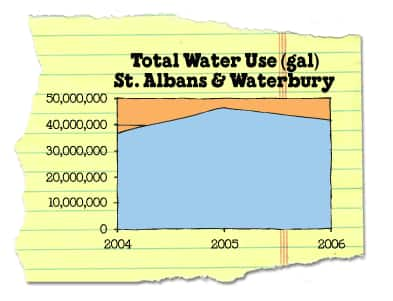
WASTE WATER
Annual wastewater goals are established at our Waterbury and St. Albans facilities to reduce the amount of water discharged to the respective towns’ municipal wastewater treatment plants. The Waterbury plant is required to pre-treat their wastewater prior to discharge. This is accomplished through the use of a Dissolved Air Flotation (DAF) unit followed by an aerobic biological lagoon to treat the waste to regulated discharge levels. The St. Albans Plant discharges directly to the municipal treatment plant.
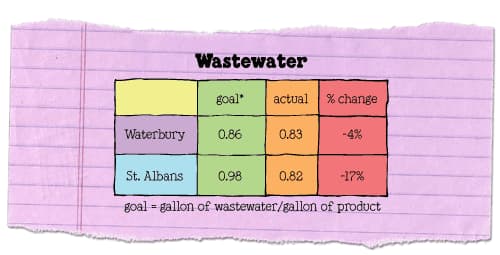
The St. Albans and Waterbury plants have continued to make improvements in their operating systems to reduce the generation of wastewater. This would include more efficient cleaning processes and greater employee awareness on water use that generates waste.
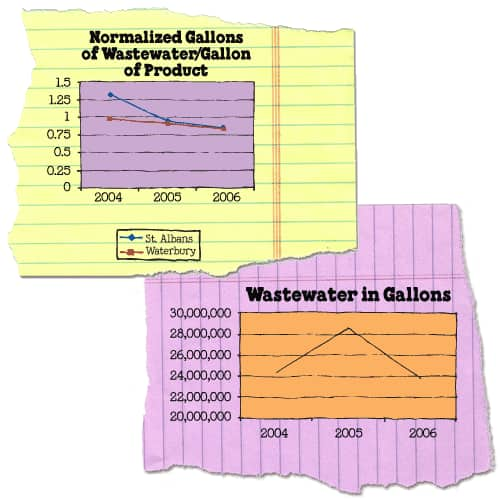
Product Waste Management
Product waste, otherwise known as High Strength Dairy Waste (HSDW), represents one of the Company’s greatest environmental impacts. Ice cream contains many ingredients with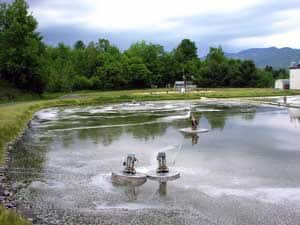 high levels of sugar and fat which, without proper management at a wastewater treatment facility, can negatively impact aquatic environments.
high levels of sugar and fat which, without proper management at a wastewater treatment facility, can negatively impact aquatic environments.
Consistent with our performance on other environmental goals, we reduced the amount of high strength dairy waste generated on a normalized basis in 2006. Both manufacturing plants successfully met their established goals, as indicated in the table below. Reductions were achieved through on-going efficiencies and attention to waste reduction.
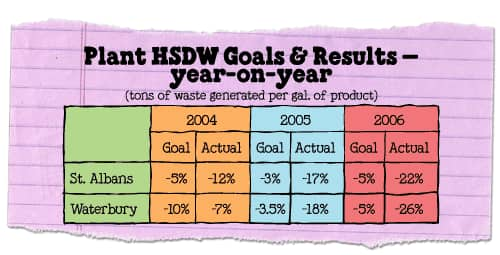
We manage our HSDW in two ways:
- through the use of permitted manure pits on Vermont farms;
- through the Intervale Center’s composting facility in Burlington Vermont.
The following chart shows how much HSDW we managed through our two options:
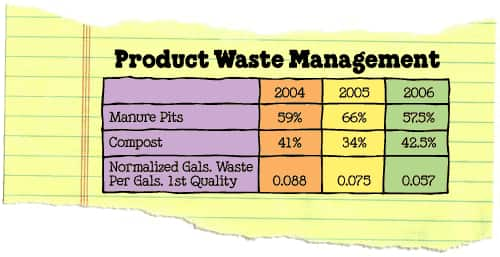
Solid Waste Management
Ben & Jerry’s tracks and measures the amount of solid waste and recycled material generated at our manufacturing plants. Recycled material, though diverted from the landfill, is still considered a solid waste. We measure the percent of recycled material as a percentage of the total solid waste stream on an annual basis. While our goal is to achieve source reduction, we still work hard at improving the amount of material that we recycle.
Packaged product, including ingredients determined to be unusable or unfit for consumption is incinerated at Covanta Energy, a waste-to-energy plant in Haverhill, Massachusetts. Waste ice cream is considered a liquid and therefore is banned from landfills.
In 2006 the manufacturing sites did an outstanding job in managing the waste stream. The overall amount of solid waste generated decreased while our recycling rate increased several percentage points to 62%. Ben & Jerry’s has continually maintained a greater than 50% recycling rate for its total waste stream and the increase to over 60% in 2006 reflects the dedication to solid waste diversion.
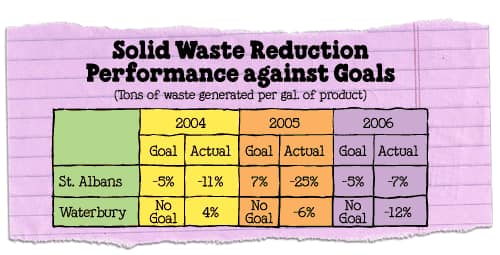
Some of the activities that contributed to the increase include:
- Increase in the number of corrugated boxes sold
- Broader input to waste reduction opportunities by employees
- Better collection containers purchased to replace old ones
In 2006 the manufacturing plants substantially decreased the amount of substandard product that required incineration at Covanta Energy’s facility. Through dedicated efforts to reduce waste and errors, the plants reduced the amount incinerated to just 399 tons, a 36% reduction below 2005 levels.
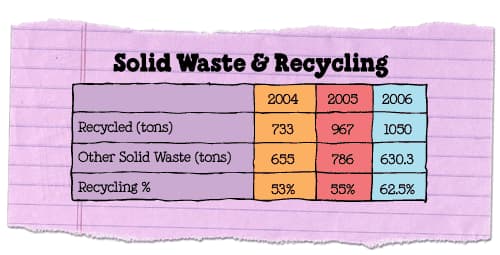
The Waterbury plant has chosen not to establish solid waste reduction goals to focus on the three most significant areas of impact, wastewater, high strength dairy waste, and biochemical oxygen demand (a regulated wastewater parameter).
Hazardous Waste Management
Given the small amount of hazardous material the Company generates, Ben & Jerry’s is considered an Exempt Small Quantity Generator (ESQG). This means that we do not generate more than 220 pounds of hazardous waste or 2.2 lbs of acutely hazardous waste on a monthly basis. The hazardous waste generated at Ben & Jerry’s facilities consists almost entirely of waste oil, water from maintaining boilers and compressors, and a small amount of methyl ethyl ketone (MEK), as detailed in the table below. The State of Vermont regulates waste oil as a hazardous waste unless it is recycled. Overall, we continue to seek innovations in our plant technologies that will ultimately eliminate any hazardous waste.

Environmental Tracking/Cost Accounting
In 1994, Ben &Jerry’s initiated an environmental tracking system that measures key environmental indicators. The areas measured include energy, carbon dioxide emissions, recycling, solid waste, wastewater, composted waste ice cream, water use and wastewater parameters. All of these indicators are normalized to gallons of production.
In addition, we collect the financial data associated with each one of the performance measures. For example, we measure not only solid waste per gallon of ice cream, we also measure the cost of solid waste per gallon of ice cream. This analysis is completed for all the areas in which we measure. We set annual goals and examine progress towards these goals on a monthly basis. The tracking tables continue to be a valuable source of information.
Regulatory Compliance
The manufacturing plants are required to maintain environmental permits for:
- wastewater discharge parameters
- stormwater management
- high strength dairy waste management
- land application of solids from our lagoons
- underground storage tanks
We also submit information under community right-to-know laws regarding hazardous materials stored at our plants.
Ben & Jerry’s has not received any state or federal violations of these permits in the past three years and maintains an excellent record for regulatory compliance.
Greening Our Workplace
Each of Ben & Jerry’s Company sites (Waterbury, St. Albans, South Burlington) has a Green Team comprised of employees interested in environmental issues. These employee-led teams come up with projects, activities and events tha t highlight relevant environmental issues within the Company and beyond.
t highlight relevant environmental issues within the Company and beyond.
In 2006, Company Green Teams initiated the following projects to support community and employee environmental awareness:
- Earth Day celebrations with daily environmental tips
- Corporate Sponsor for “Vermont Green Up Day” in which employees participated in road clean-up projects near their facility
- Arbor Day celebration — young spruce tree give-away to employees
- “Pedal for Progress” — a nonprofit that collects bikes and donates them to underprivileged people throughout the world who need bikes to get to jobs, attend school or get produce to market
- Teamed with the Solid Waste District for the Annual community Christmas tree mulching event that included food shelf donations
- “Environmental Tidbits” — regular e-mail topics focused on environmental issues that employees may find interesting
- Donation of T-8 Bulbs to a local school after the site upgraded their energy efficient lights
- Worm composting workshop for employees and local residents
Sounds Cool!
Thermoacoustic Refrigeration (TAR) is an alternative refrigeration technology that utilizes sound waves to create cooling, as opposed to the traditional means of mechanical refrigeration reliant on the compression and expansion of specialized  gases. Since there are more than 1.8 million ice cream cabinets in use worldwide, TAR has the potential to eliminate a significant amount of environmentally harmful and flammable gases from the process of mechanical refrigeration.
gases. Since there are more than 1.8 million ice cream cabinets in use worldwide, TAR has the potential to eliminate a significant amount of environmentally harmful and flammable gases from the process of mechanical refrigeration.
In 1999, Ben & Jerry’s first teamed up with Acoustics Professor Steven Garrett and fellow researchers at Penn State’s Applied Research Laboratory, where we helped fund a project to develop an environmentally-friendly, compact freezer cabinet that uses thermoacoustic technology.
In 2002, Ben & Jerry’s and Unilever Research partnered to fund a second round of research on TAR at Penn State University.
At the 2004 Earth Day Celebration in New York City, Penn State researchers and Ben & Jerry’s successfully debuted the first working ice cream cabinet powered by a thermoacoustic engine. The engine was functionally integrated into a standard ice cream cabinet and demonstrated in use, cooling ice cream for two public events. Both of these initial presentations showed that ice cream could be cooled to practical operating temperatures (-20° C) and could overcome typical field conditions (125 W of cooling power) using a thermoacoustically-powered device. The operating prototype and related research was also presented at the Refrigerants, Naturally Conference in Brussels,  Belgium, on June 22, 2004. This conference, co-sponsored by the United Nations Environmental Program, Greenpeace, Unilever, Coca-Cola and McDonalds, is a forum dedicated to exploring and presenting the latest developments in mechanical refrigeration that do not rely on environmentally-harmful gases such as HFCs and CFCs.
Belgium, on June 22, 2004. This conference, co-sponsored by the United Nations Environmental Program, Greenpeace, Unilever, Coca-Cola and McDonalds, is a forum dedicated to exploring and presenting the latest developments in mechanical refrigeration that do not rely on environmentally-harmful gases such as HFCs and CFCs.
At Ben & Jerry’s we launched a fun, animated presentation called “Sounds Cool,” on our website, which included information about the environmental dangers of common refrigerants; the options that thermoacoustics and alternative technologies offer; and links to additional information.
Our funded research on TAR ended in 2004 with the completion of the prototype. Still, Ben & Jerry’s intends to find new ways to support this developing technology by exploring options for beta testing of early commercial units.
In 2004, Penn State negotiated the sale of intellectual property rights to the newly founded Thermoacoustics Corporation (TAC). Penn State researchers also secured two additional years of venture capital funding from the TAC to continue research into commercial application of the technology.
In 2005, Thermoacoustic Corporation (TAC) shifted its focus from ice cream cabinet applications to other classes of cooling equipment in collaboration with a third party joint development partner. This initiative, while not targeted toward a device that Ben & Jerry’s might immediately use in its distribution system, is very promising in that it may lead to establishing the commercial viability of this emerging, environmentally superior technology for use in other mechanical cooling applications. Ben & Jerry’s was not under contract with Penn State or TAC for research in 2006. Ben & Jerry’s Research and Development department continues to stay in close contact with TAC and has offered assistance with providing potential test applications of the emerging devices, if applicable.
WORKPLACE
GOOD WORK
2006 shaped up to be a relatively stable year for our Company. Unlike the previous few years, we experienced no significant restructuring within our organization. This stability, 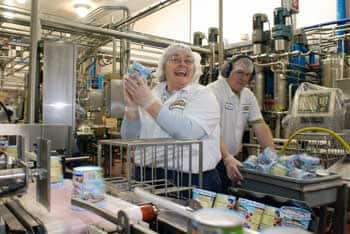 improved communication within our office, and a renewed focus on employee recognition helped bring back the upbeat work culture and sense of community that we’ve always valued.
improved communication within our office, and a renewed focus on employee recognition helped bring back the upbeat work culture and sense of community that we’ve always valued.
More change is on the horizon. In 2006, our parent company, Unilever, announced that it will outsource worldwide HR functions to Accenture. The pending change required the alignment of Ben & Jerry’s benefits package with the rest of Unilever North America, which resulted in some significant changes in 2006. We also expect that the change will impact roles and responsibilities within Ben & Jerry’s Human Resources Department in the next 12 to 18 months.
Compensation
At Ben & Jerry’s we believe the Company’s financial success should be shared by all stakeholders rather than concentrated at the top of our management structure. Part of the Company’s Economic Mission is to create career opportunities and financial rewards for our employees, a commitment in line with our Social Mission.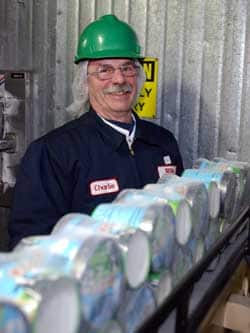
Livable Wages
Ben & Jerry’s is committed to paying all of its full-time manufacturing workers a livable wage. In 1995 we established a method for calculating a livable wage benchmark for Vermont. We defined it as the starting wage for a single person that will sustain a quality of life to include expenditures for housing, utilities, out-of-pocket health care, transportation, food, recreation, savings, taxes, and miscellaneous expenses. Since then, we’ve adjusted this livable wage annually, based in part on COLA (Cost-of-Living Adjustment) data published by the government, to ensure the relative value is sustained in today’s marketplace.
For the first time since acquisition, in September 2006, we completed a comprehensive evaluation of our livable wage benchmark. The results showed that the Cost Of Living Adjustment (COLA), as published by the federal government, hasn’t kept pace with the true cost of living in Vermont. So we recalculated a new 2006 livable wage benchmark, arriving at a revised figure of $11.78/hour, up from $10.38/hour in 2005. The new livable wage impacted 82 employees in our plants, who received an increase in their base wage and overtime wage retroactive to April 2006. The total amount that Ben & Jerry’s paid out in 2006 for the purpose of ensuring livable wages was $103,000.
Ben & Jerry’s livable wage benchmark for 2006 translates to $24,502 per year. For comparison, in 2006, the minimum wage in Vermont was $7.25/hr ($15,080/yr) and the national minimum wage was $5.15/hr ($10,712/yr).
Bonus Incentive Plans
Every full-time Ben & Jerry’s employee is eligible for some form of variable pay over and above their base pay. The bonus plans provide an added incentive to achieve sound business results and to build skills and competencies within the Company.
In 2006, Ben & Jerry’s salaried exempt employees, non-exempt employees and managers were eligible for the Variable Pay Award (VPA) plan which allocates bonuses based on the Company’s financial performance and the individual’s progress on goals and targets.
Ben & Jerry’s full-time hourly manufacturing employees were eligible for bonuses in 2006 through a “Keys to Enterprise” (KTE) plan, which replaces the Performance and Savings Incentive Plan of previous years. The KTE plan, a North American Ice Cream (NAIC) bonus plan, paid out an average of $533 in 2006.
Benefits
More Than a Paycheck
The benefits package for Ben & Jerry’s employees changed in significant ways in 2006, as the Company’s benefits were brought into alignment with Unilever’s other business units in North America. Notable changes included: the rollover of Ben & Jerry’s 401 (k) retirement program to Unilever’s program, managed by Fidelity; a new matching formula for employees’ 401 (k) contributions; new health and dental insurance carriers; a new severance pay formula; extended maximum disability payments; and a revised personal time accrual schedule. Ben & Jerry’s still offers some unique benefits over and above Unilever’s package, too.
Altogether, our benefits remain competitive within the industry and represent an important part of our relationship with employees. Here’s a quick view of a few of our favorites:
- generous paid time off
- a 401 (k) plan with a 5% Company match
- a choice of health insurance plans
- dental, health and life insurance
- onsite workout facility at Central Support Office — new for 2006!
- 40 hours of paid time off for community service work (Central Support employees)
- education tuition reimbursement
- three free pints of ice cream per day
- health club membership
- $1,000 hybrid automobile purchase incentive
- a pet-friendly workplace
- DaVinci nap room for re-energizing
- Milky Way room for nursing moms
Benefits Cost
The average cost (to the Company) of benefits per employee in 2006 was $12,667 as compared to $12,043 in 2005. This modest 5% increase was achieved in part by cost savings that resulted from the alignment of Ben & Jerry’s benefits package with the common plan administered through the Unilever Benefits Services Center.
The spiraling cost of health care in the United States continues to be a challenge for people and companies around the country. Ben & Jerry’s is no exception. Mirroring national trends, the health insurance plans offered to Ben & Jerry’s employees were generally more expensive for employees in 2006. However, the health insurance plans offered by Ben & Jerry’s do provide employees a variety of options to fit their needs.
Diversity & Gender Balance
Diversity
Ben & Jerry’s believes in and promotes workplace diversity. We think we’re a better company when we can draw on different perspectives, backgrounds, and abilities among our employees. For example, in the spirit of welcoming diversity, for many years we’ve attracted individuals of varying sexual orientation; for just as long, we’ve offered benefits programs that recognize and support partnerships other than traditional marriage.
Historically, the workforce at our manufacturing plants and corporate offices has reflected the demographic patterns of Vermont, with relatively little racial diversity. In 2006, this continued to be true, as the diversity ratio within our Company was measured at 3.5%. This suggests that our 8.0% diversity ratio in 2005 was a temporary spike. We have not undertaken a specific analysis to understand why we’ve seen such a large fluctuation in this metric over the past two years.
However, we do continue to use critical tools, such as Equal Employment Opportunity (EEO) and Affirmative Action Plan (AAP) guidelines to track important diversity information. In 2006 Ben & Jerry’s completed our first-ever Affirmative Action Plan for Minorities and Women which is a good HR practice and in line with Unilever guidelines. The results indicated that there were no job groups among minorities or women experiencing statistically significant adverse impacts in promotions or terminations.

Gender Balance
We are committed to gender equity in our employment practices. In 2006, 64% of our full-time workforce was male and 36% was female, which represents a slight change from 2005, when we measured a 62-38 split.
We did see some changes in the gender salary ratios of our workforce in 2006. Among our manufacturing and administrative employees, the average wage we paid to female employees moved to full parity with males in 2006. In all other employment categories, however, average male wages rose relative to female wages. We have yet to analyze the data to understand what’s behind these changes.
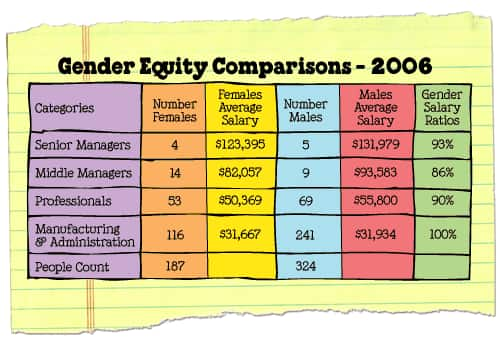
Survey Says...Not This Year!
Every two years, Unilever employees worldwide participate in a Global People Survey (GPS) contributing their feedback on a wide range of topics related to the Company’s performance and practices. The survey is a useful tool for taking the pulse of our employees, allowing us to better understand the relationship between our people, the organization, and our business development.
This survey was not conducted in 2006 as planned. Unilever’s management decided to postpone the survey until mid-2007 to better position it in the overall business planning cycle and to relieve some of the pressure on our global Human Resource organization, which is in the midst of a global restructuring and transition to an outside provider. It is anticipated that the GPS will be completed in the summer of 2007.
Company Culture
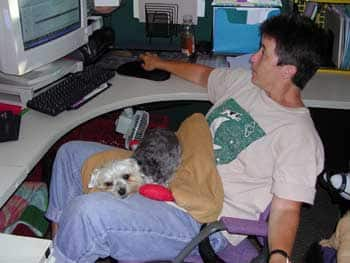 Within our own backyard, we continue to value our niche as a unique brand with a unique style within the larger, more complex organization of Unilever. This approach is reflected in Ben & Jerry’s workplace practices and in our company culture. In our Central Support Office, we still share company-sponsored employee lunches from time to time, hold fun and spontaneous celebrations organized by the Joy Gang and the Green Team, and get ice cream regularly at our very own Scoop U. Pets and kids are welcome in our office, too. New for 2006, a brand-new exercise facility and a series
Within our own backyard, we continue to value our niche as a unique brand with a unique style within the larger, more complex organization of Unilever. This approach is reflected in Ben & Jerry’s workplace practices and in our company culture. In our Central Support Office, we still share company-sponsored employee lunches from time to time, hold fun and spontaneous celebrations organized by the Joy Gang and the Green Team, and get ice cream regularly at our very own Scoop U. Pets and kids are welcome in our office, too. New for 2006, a brand-new exercise facility and a series  of fitness classes in our office have helped many of us on our quest to turn the ice cream calories into endorphins! And, with management leading the way, we’ve continued to strive for a balance between work and personal commitments in a busy workplace.
of fitness classes in our office have helped many of us on our quest to turn the ice cream calories into endorphins! And, with management leading the way, we’ve continued to strive for a balance between work and personal commitments in a busy workplace.
Leadership Team
Through 2005 and 2006, Ben & Jerry’s senior leadership team, known as the Managers of the Mission (MOM) focused on two goals in addition to their normal leadership and operating responsibilities: the completion of an intensive, creative leadership development program and the creation of a new Company Vision Statement.
Both have infused new energy into our organization and our work. The leadership development program was so successful that it will be extended to twelve more managers in 2007. The Company Vision statement was presented to employees at a site meeting in the summer of 2006, where employees were invited to discuss the statement and give examples of ways we were living our vision and examples of where we could improve. Going forward, it promises to guide us as a values-led business within a larger organization.
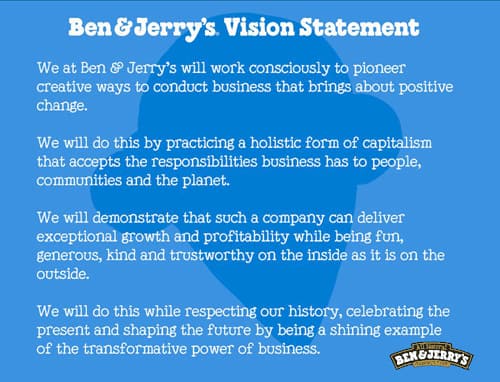
Communication
In 2006, we continued to implement programs that enhance ongoing communication processes and ensure a working environment that’s open to discussion and feedback. The MOM sponsored several “Town Meetings” throughout the year for information sharing on business issues. Site meetings, scheduled quarterly, kept all employees in touch with the Company’s business results and current priorities. The consensus was that these improved communications and were generally well received by employees.
Employee Recognition
In an effort to foster on-going positive recognition for work well done, we continued to promote our Rewards and Recognition program in 2006. We also committed to measuring the level of participation in these programs for 2006.
- The Service Award recognizes employees who’ve been at Ben & Jerry’s for five years and more through gifts, cash, and/or travel vouchers in a tiered system. In 2006, 253 employees were awarded Service Awards.
 The Busted Hump award gives employees an opportunity to recognize their peers for timely and tangible “everyday” contributions to our business and to our values-led mission. Recognized employees receive a certificate of appreciation and a gift certificate to a local establishment valued at $50. In the fall of 2006, 23 employees were awarded Busted Hump Awards.
The Busted Hump award gives employees an opportunity to recognize their peers for timely and tangible “everyday” contributions to our business and to our values-led mission. Recognized employees receive a certificate of appreciation and a gift certificate to a local establishment valued at $50. In the fall of 2006, 23 employees were awarded Busted Hump Awards.- The Golden Cone Award, given annually, is an opportunity for the Company to recognize, reward and celebrate employees for truly exceptional contributions that enhance the business while still preserving and promoting Ben & Jerry’s culture, Social Mission and organizational values. Recipients of this prestigious award receive an engraved statue and a cash gift of approximately $2,000. In 2006, two employees were awarded Golden Cone Awards.
- The Applause Pause, formerly awarded only by HR managers, was revised so that any employee can recognize and celebrate a peer’s contribution with a spontaneous financial pat on the back for a job well done. There’s a certificate of appreciation and Ben Bucks (up to $25.00 equivalent) for recognized employees, all redeemable at the Unilever Employee Store and most Ben & Jerry’s Scoop Shops.
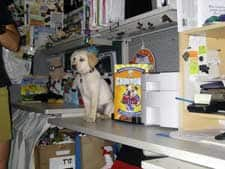 In addition to these “formalized” recognition programs, we continued with Hats ’N Cones at quarterly Site Meetings to honor employees for each completed year of service with the Company.
In addition to these “formalized” recognition programs, we continued with Hats ’N Cones at quarterly Site Meetings to honor employees for each completed year of service with the Company.
Turnover
Total Ben & Jerry’s employee turnover for the year, excluding those receiving severance, was recorded at 12.3% compared to 11.9% in 2005. This number is lower than the 14.9% average turnover for manufacturing businesses in the Northeast.
GIVING BACK
A FOUNDING BELIEF
Company co-founder Ben Cohen once said, “Business has a responsibility to  give back to the community.” Not only did that sentence make a good bumper sticker; it has inspired us over the years to think carefully about the many communities where we have a presence — and the meaningful ways we can make a contribution to their quality of life.
give back to the community.” Not only did that sentence make a good bumper sticker; it has inspired us over the years to think carefully about the many communities where we have a presence — and the meaningful ways we can make a contribution to their quality of life.
The Ben & Jerry’s Foundation
The Ben & Jerry’s Foundation, a separate entity from the Company, was established in 1985 through a donation of stock in Ben & Jerry’s Homemade, Inc. Its mission is to make the world a better place by empowering Ben & Jerry’s employees to use available resources to support and encourage organizations that are working towards eliminating the underlying causes of environmental and social problems. Its core areas of interest include economic and social justice, environmental stewardship, and peace through understanding in Vermont and other communities throughout the United States.
Visit the website of Ben & Jerry’s Foundation.

Funding
In 2006, the Ben & Jerry’s Foundation received $1,587,917 from Ben & Jerry’s Homemade, Inc., based on 2005 sales of the Company. This represents a 9.1% increase over the previous year.
Employee-directed grantmaking
Most of the grants awarded to nonprofit organizations by the Ben & Jerry’s Foundation each year are directed by Ben & Jerry’s employees. In 2006, these grants totaled $1,133,985.
The U Fund
The Ben & Jerry’s Foundation trustees make grants to organizations involved in education and activism around globalization and social justice from a special fund that was established when Unilever acquired Ben & Jerry’s in 2000. Learn more.
Other grants
Learn about the Plant Managers’ Discretionary funds and other small grants the Foundation makes.
Grant recipient spotlight:
The Ben & Jerry’s Foundation is especially pleased to recognize two of our grantees who have been awarded prestigious social justice and environmental prizes.
The Chemical Weapons Working Group, a project of the Kentucky Environmental Foundation, was given renewed funding in 2006 for their work mobilizing the grassroots around the country to force the Pentagon to deploy safe technologies in the destruction and remediation of stockpiled and non-stockpiled chemical weapons. The Ben & Jerry’s Foundation has supported this organization and its founder, Craig Williams, since 1995 for their very influential and daunting work, holding the Pentagon accountable for the safe remediation of their toxic weapons legacy. We are extremely proud that Craig was named the 2006 winner of the prestigious Goldman Environmental Prize.
The Sadie Nash Leadership Project was sponsored by the Foundation to lead an inspiring leadership training workshop for Ben & Jerry’s Scoopers Making Change program in Vermont in July 2006. SNLP has been promoting leadership and activism among young women in the New York area since 2001, receiving Ben & Jerry’s Foundation support in 2003 and again in 2005. SNLP was awarded the 2006 Union Square Award for their successful grassroots activism and social impact.
Give the Gift of Giving Alternative Holiday Market
As part of our mission to empower Ben & Jerry’s employees and nurture and support their philanthropic spirit,Ben & Jerry’s Foundation hosted our first annual “Gift of Giving” alternative holiday market. We invited 14 local non-profit organizations to come and table in our lobby and talk about the good work they are doing in our community. Employees and the public were invited to “shop” for donations to give to family, friends and business associates. The day was festive as our lobby was festooned with lights and filled with holiday cookies and music. 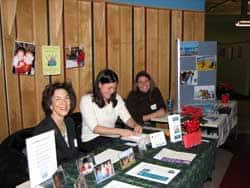 Many employees volunteered their time to greet visitors, inscribe gift cards and shepherd people to Scoop U. which was opened to scoop ice cream for the occasion. We raised close to $3,000 for the participating organizations, $1,000 of which was matched by our employee Matching Gift program.
Many employees volunteered their time to greet visitors, inscribe gift cards and shepherd people to Scoop U. which was opened to scoop ice cream for the occasion. We raised close to $3,000 for the participating organizations, $1,000 of which was matched by our employee Matching Gift program.
EMPLOYEE DIRECTED GRANT MAKING
Ben & Jerry’s employees are extensively involved in the grant-making activities of the Ben & Jerry’s Foundation because the Foundation’s monies derive from the hard work of the Company’s staff. The Foundation administers three programs that award grants under the direction of Ben & Jerry’s employees.
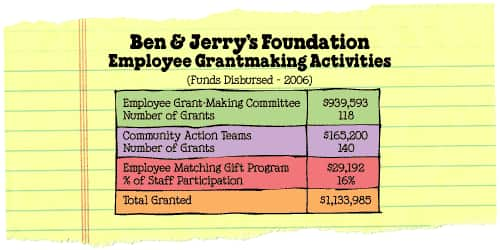
National Grant-making Program
A nine-member Employee Grant-making Committee representing each of the three Ben & Jerry’s sites in Vermont makes grants to national and Vermont-based nonprofit organizations to support progressive social change and environmental work. Members volunteer to join the committee and are selected by Foundation staff. They are expected to serve three-year terms. Grants are made ten times a year and range from $500 to $15,000.
In 2006 the Employee Grant-making Committee distributed $939,593 in grants.
A complete list of national grants can be found on the Foundation website
Site Community Action Teams
Each of the Company’s Vermont sites (Waterbury, St. Albans, South Burlington) also has an employee Community Action Team or CAT. These teams review and decide on small grant requests, generally $100 to $1,000, to support the work of local, Vermont-based, nonprofit organizations.
In 2006 the three Community Action Teams distributed $165,200 in grants to organizations such as:
- Rural Community Transportation, Inc.
- Women’s Rape Crisis Center
- South Hero Land Trust
- Intervale Foundation
Employee Matching Gift Program
In order to encourage and support employees’ personal generosity, the Ben & Jerry’s Foundation initiated an Employee Matching Gift Program in 1998. When employees make donations to nonprofits of their own choice, the Foundation matches dollar-for-dollar up to $2,000 per employee annually.
In 2006, 16% of staff participated and the Ben & Jerry’s Foundation matched $29,192 in employee donations.
THE U FUND
The trustees of the Ben & Jerry’s Foundation oversee and administer a one-time, $5 million gift that resulted from Unilever’s acquisition of Ben & Jerry’s in 2000. These funds are granted proactively to nonprofit organizations that support citizen education and activism around globalization issues and social justice.
In 2006 the Trustees distributed $100,000 in U Fund grants to five organizations.
- $25,000 to Unembedded, a traveling photo exhibit bringing together 60 photographs by four independent photographers. Together they present rare windows on the war in Iraq from the invasion in March 2003 to early 2005. Working outside the confines of the U.S. military’s official journalist embedding program, these photographers document issues and events often underreported by mainstream media.
- $25,000 to the Center for Community and Corporate Ethics, an organization that launched Wal-Mart Watch to focus on the business practices of the world’s largest retailer and other big-box retail stores.
- $10,000 to Africa Action, a group working to change U.S. foreign policy and the policies of international institutions in order to support African struggles for human rights, peace and development. Ben & Jerry’s Foundation funds were used specifically to shape public discourse on Darfur and to expose the U.S. failure to act to prevent genocide.
- $20,000 to Rainforest Action Network’s Global Finance Campaign. Rainforest Action Network, together with allies and activists around the world, works to redirect the global economic system away from environmentally and socially destructive activities and into clean, sustainable, and socially just alternatives. After years of grassroots activism and campaigning by countless RAN volunteers, America’s three largest banks, Citigroup, Goldman Sachs, and JPMorgan Chase, have all adopted policies that safeguard old growth and endangered forests, curb investments in projects that contribute to climate change, and protect the rights of indigenous peoples.
- $20,000 to Corporate Accountability International, a membership organization that protects people by waging and winning campaigns that challenge irresponsible and dangerous corporate actions around the world. For nearly 30 years, Corporate Accountability International and their members have scored major victories that protect people’s lives by forcing corporations like Nestlé, General Electric and Philip Morris/Altria to stop abusive practices. Support was given for their Water Industry Campaign.
OTHER GRANTS
Other Foundation Grants
The Foundation trustees and staff may make grants to nonprofit organizations in the areas of children and families, environmental restoration, sustainable agriculture and peace through understanding; or, in support of the Company’s Social Mission initiatives. Grants to support the Company’s Social Mission programs are not used for sponsorships, promotions or other marketing purposes.
In 2006, $100,000 was distributed in other grants to various organizations including:
- $5,000 to NeighborKeepers, an anti-poverty program, for general support
- $5,000 to DREAM, a youth mentoring organization, for general support
- $4,000 to the Vermont Natural Resources Council to sponsor a public appearance by author and water rights activist Maude Barlow.
Plant Managers’ Discretionary Fund
$5,000 is made available each year to the plant managers at the St. Albans and Waterbury sites. The fund is used for corporate citizenship purposes and supports activities of local civic organizations that may not be eligible for Community Action Team (CAT) grants.
In 2006, the Plant Managers’ contributions included Green Mountain Habitat for Humanity.
COMMUNITY ACTION TEAMS
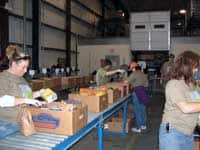 Along with its grant-making activities, the Ben & Jerry’s Foundation also organizes Community Action Teams (CATs) at each of the Company’s Vermont sites (Waterbury, St. Albans, South Burlington). These Ben & Jerry’s employee teams work with their site management to identify, undertake and underwrite community projects in cooperation with a 501c(3) approved Vermont nonprofit or a municipal entity. Members of the CATs are chosen by their peers and serve
Along with its grant-making activities, the Ben & Jerry’s Foundation also organizes Community Action Teams (CATs) at each of the Company’s Vermont sites (Waterbury, St. Albans, South Burlington). These Ben & Jerry’s employee teams work with their site management to identify, undertake and underwrite community projects in cooperation with a 501c(3) approved Vermont nonprofit or a municipal entity. Members of the CATs are chosen by their peers and serve 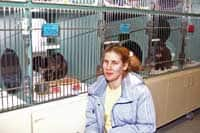 for three-year terms.
for three-year terms.
In 2006 the CAT community projects included:
- weeding and other tasks at the Foodbank Farm in Barre, Vermont. The farm’s mission is to grow organic produce for food banks throughout the state.
- sorting food donations at the Vermont Food Bank in Barre, VT
- painting cabins at Camp Abnaki and Camp Hochelaga, YMCA summer camps for children on Lake Champlain
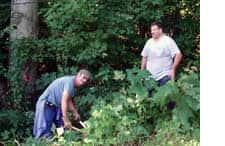 blazing trails and clearing paths at the community-owned Hard’ack ski and sled recreation site in St. Albans, Vermont
blazing trails and clearing paths at the community-owned Hard’ack ski and sled recreation site in St. Albans, Vermont- working on riverbank restoration efforts along the Mississquoi River to reduce soil erosion and nutrient runoff from farms in the Lake Champlain basin
- helping with maintenance projects at community skating rinks in Waterbury and Morrisville, Vermont
- cleaning and maintenance at the North County Animal League in Morrisville, Vermont
 CATs also review and decide on small grant requests for local, Vermont based, nonprofit organizations. Learn more about the CATs’ grant-making activities.
CATs also review and decide on small grant requests for local, Vermont based, nonprofit organizations. Learn more about the CATs’ grant-making activities.
Giving it Away
 Lots of people think Ben & Jerry’s ice cream is a great excuse for getting together. That’s why we love to donate our ice cream to support the activities of nonprofit organizations around the country. It’s a way we help all kinds of groups celebrate a special event, draw a crowd to raise awareness of an important issue, or advance fundraising efforts.
Lots of people think Ben & Jerry’s ice cream is a great excuse for getting together. That’s why we love to donate our ice cream to support the activities of nonprofit organizations around the country. It’s a way we help all kinds of groups celebrate a special event, draw a crowd to raise awareness of an important issue, or advance fundraising efforts.
- In 2006, Ben & Jerry’s donated $132,000 worth of ice cream to various organizations through the US and Canadian distribution centers managed by Unilever, our parent company. This total includes bulk tubs, pints, mini-cups, ‘Wiches and ice cream bars.
- In response to small donation requests, we also gave away 12,381 free Ben & Jerry’s pint coupons to support the work of over 1,000 nonprofits outside the state of Vermont.
- Closer to home, Ben & Jerry’s donated over 700 gallons of ice cream to Vermont nonprofits through Vermont’s Finest, our in-state distributor.
- Ben & Jerry’s corporate office sponsored over two dozen community events in Vermont in 2006, ranging from the Special Olympics to an AARP voter registration drive. At many of these events, we rolled out our famous Scoop Truck to dole out free ice cream to anyone willing to stand in line for a few minutes. All together, we donated over 500 gallons of ice cream and hundreds of hours of staff time at these community events.
- In Vermont, New York, and Las Vegas, Ben & Jerry’s company-owned Scoop Shops gave away $28,500 worth of ice cream to support community nonprofits.
- On top of the Company’s donations, our franchisees in Scoop Shops gave away thousands of gallons of ice cream to support the work of nonprofit organizations in their local markets in 2006. To spur
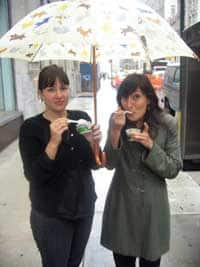 themselves on to even greater heights of generosity and community involvement, franchisees collectively set aside $40,000 to fund a unique Matching Bulk Program that reimburses individual Scoop Shop owners for half of the cost of donated ice cream. Learn more about how franchisees used these product donationsto make a difference in their communities.
themselves on to even greater heights of generosity and community involvement, franchisees collectively set aside $40,000 to fund a unique Matching Bulk Program that reimburses individual Scoop Shop owners for half of the cost of donated ice cream. Learn more about how franchisees used these product donationsto make a difference in their communities.
The Silver Lining
Although we fancy ourselves master ice-cream makers, we do occasionally produce a batch of ice cream that doesn’t meet our highest quality standards — what we like to call a ‘factory second.’ But a pint with too much cherry and not enough Garcia can still be pretty tasty. So we’ve run an innovative program for over 20 years to turn these honest mistakes into funds to support local Vermont service organizations through the Mom-and-Pop stores who carry our ice cream.
Here’s how it works: When we happen to make a batch of factory seconds, we sell them at a deep discount over the first-quality price to selected Mom-and-Pop stores around Vermont. These stores, in turn, pass along a bargain price to customers, and designate a local service organization they’d like to support. For each pint of factory second ice cream sold, Ben & Jerry’s pays 35 cents to the designated organization.
In 2006, we sold 32,832 pints of factory seconds and contributed $11,491 to about 50 organizations through our Factory Seconds program. Recipients included animal shelters, community and recreation centers, and over a dozen local fire departments.
Rolling Up Our Sleeves
 Participation in community action projects is one of the most enjoyable ways for Ben & Jerry’s employees to give back to the community. Over the years, we’ve made a tradition of many of these projects.
Participation in community action projects is one of the most enjoyable ways for Ben & Jerry’s employees to give back to the community. Over the years, we’ve made a tradition of many of these projects.
CAT Team Community Service Day
In our own backyard, we commit one day a year to a Company service project, organized by the Community Action Teams (CATs) at each of our three Company sites. Learn more about the CAT projects we completed in 2006.
Franchise Community Service Project
Our annual Franchise Community Gathering meeting, held in a different location every year, includes a service project with Ben & Jerry’s corporate employees and Scoop Shop owners in the city where we gather. Learn more about our recent projects in San Diego and New Orleans.
Community Volunteering
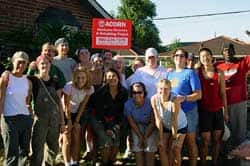 Our Central Support Office in South Burlington extends a community service benefit to every employee, allowing them to take 40 hours of paid time off to volunteer with a nonprofit organization.
Our Central Support Office in South Burlington extends a community service benefit to every employee, allowing them to take 40 hours of paid time off to volunteer with a nonprofit organization.
 In 2006, a crew of seven Ben & Jerry’s employees returned to New Orleans, fifteen months after Hurricane Katrina, to spend another week on the city’s continuing clean-up efforts. Under the leadership of ACORN, a community organization of low–to moderate–income families, this team worked alongside several families to remove damaged furnishings, floors,
In 2006, a crew of seven Ben & Jerry’s employees returned to New Orleans, fifteen months after Hurricane Katrina, to spend another week on the city’s continuing clean-up efforts. Under the leadership of ACORN, a community organization of low–to moderate–income families, this team worked alongside several families to remove damaged furnishings, floors,  and walls from their previously flooded homes. Ben & Jerry’s once again supported the work of these staunch employee volunteers with a travel budget for the trip to New Orleans.
and walls from their previously flooded homes. Ben & Jerry’s once again supported the work of these staunch employee volunteers with a travel budget for the trip to New Orleans.
We still don’t have good data on how many other employees used the community service benefit in 2006, a shortcoming we noted in this report last year. We’ll work on creating such a system in 2007.
Valentine’s Day fundraiser
Our Central Support office employees celebrated Valentine’s Day 2006 by giving flowers and cards to co-workers — and raising money for Women Helping Battered Women at the same time. Flower and card sales brought in $550 with a match from the Ben & Jerry’s Foundation.
Project Joy
Ben & Jerry’s organizes this project each year around the holidays to reach out to communities in Vermont facing economic hardship. In 2006, our Central Support Office worked with Northeast Kingdom Community Action in Canaan, Vermont. Inspired by a stack of handwritten wish lists, our employees purchased, wrapped, and sent presents and books to 36 children from 16 families in crisis.
R&D Christmas Cookie Sale
Ben & Jerry’s Flavor Gurus like to do a little cross-training in the kitchen during the holiday season, so each year they turn their talents to baking some irresistible Christmas cookies and selling them to folks here in the Central Office. In 2006, they donated proceeds from cookie sales — plus a Ben & Jerry’s Foundation match – totaling $1,323 to the WARMTH program, which funds emergency heating oil supplies for low-income families in Vermont.
Holiday Food Drive
The Facilities and Human Resources teams spearheaded a Food Drive challenge for all the departments in our Central Support Office in November 2006 that collected 1,454 pounds of food for the Chittenden Emergency Food Shelf. The Design Department led the way by collecting 372 pounds of food, more than any other department!
CONSUMER SERVICES
CONNECTING WITH CONSUMERS
For years, we’ve known that folks who love what’s in our ice cream are likely to care just as much about what’s behind it. They read the messaging on our packages, hang out at the Ben & Jerry’s website, dig up our media coverage — for better and for worse — and speak out about how they feel. For this we’re thankful.
We try to hold up our end of the bargain by keeping our Company values front and center in our ongoing dialogue with consumers.
Social Mission Campaigns
While Ben & Jerry’s has always been a brand built for fun, we do take a number of substantive issues very seriously. Sustainable agriculture; care for our environment; social justice and equality; peace without violence are among them. Learning to stand up for the values we believe in has been a journey. Along the way, we think we’ve made some noise with issue-based campaigns, hopefully motivated action, and maybe even inspired a few solutions.
In 2006, we took on several issues, large and small. Here’s a quick rundown of the roads we followed. Click through to learn more.
AMERICAN PIE TOUR
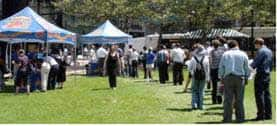 We hit the road in 2006 on an eight-city tour to promote common sense priorities in the U.S. federal budget, asking Americans to support the basic needs of children instead of new nuclear weapons systems. We supported the tour with an interactive website and our American Pie ice cream — and paid the postage on thousands of postcards to Congress.
We hit the road in 2006 on an eight-city tour to promote common sense priorities in the U.S. federal budget, asking Americans to support the basic needs of children instead of new nuclear weapons systems. We supported the tour with an interactive website and our American Pie ice cream — and paid the postage on thousands of postcards to Congress.
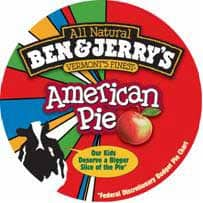 For over a decade, Ben & Jerry’s has spoken up for common sense, progressive priorities in the federal budget. In fact, one part of our company’s statement of values says, “We believe government resources are more productively used in meeting human needs than in building and maintaining weapons systems.”
For over a decade, Ben & Jerry’s has spoken up for common sense, progressive priorities in the federal budget. In fact, one part of our company’s statement of values says, “We believe government resources are more productively used in meeting human needs than in building and maintaining weapons systems.”
 In 2006, we looked at the $30 billion in the U.S. budget earmarked for nuclear weapons spending — while millions of American children are living in poverty or without health insurance — and we decided the time was right to speak out on this important issue once again.
In 2006, we looked at the $30 billion in the U.S. budget earmarked for nuclear weapons spending — while millions of American children are living in poverty or without health insurance — and we decided the time was right to speak out on this important issue once again.
In May, we launched the American Pie Campaign. We churned  up a limited batch of American Pie ice cream and used the pint package to raise awareness about federal spending priorities. The pint lid itself features a pie chart of the federal discretionary budget.
up a limited batch of American Pie ice cream and used the pint package to raise awareness about federal spending priorities. The pint lid itself features a pie chart of the federal discretionary budget.
With our partners at The Children’s Defense Fund, the Natural Resources Defense Council, the Center for Defense Information, the National Priorities Project, and True Majority, we also launched an interactive American Pie website to educate visitors about the federal budget and the basic unmet needs of millions of children in America.
Just for the site, we created an original American Pie quiz game, a short Kids Count Flash movie, a budget allocation game, a link to co-founder Ben Cohen’s BB Demonstration, and a link to the Children’s Defense Fund, where people could take action by contacting Congress. The site peaked at 105,000 page views in July and averaged almost 45,000 per month from May to September.
 Just in time for summer, we hit the road with a mobile American Pie Tour, spending five days in Washington, DC; Boston; Chicago; San Francisco; Denver; and Portland, OR. In each city, the tour featured games, educational materials, postcard writing stations, and free samples of American Pie.
Just in time for summer, we hit the road with a mobile American Pie Tour, spending five days in Washington, DC; Boston; Chicago; San Francisco; Denver; and Portland, OR. In each city, the tour featured games, educational materials, postcard writing stations, and free samples of American Pie. In all, we scooped over 11,000 free samples of ice cream and collected 2,450 postcards to send to Congress in support of common sense budget priorities. Children’s Defense Fund representatives participated in several events, and co-founders Ben and Jerry even joined us for our stop in Washington, DC.
In all, we scooped over 11,000 free samples of ice cream and collected 2,450 postcards to send to Congress in support of common sense budget priorities. Children’s Defense Fund representatives participated in several events, and co-founders Ben and Jerry even joined us for our stop in Washington, DC.
We also activated the campaign in Ben & Jerry’s Scoop Shops around the country. In many of our stores, table top easel boards featured American Pie messaging and scoopers distributed Federal Spending position papers with tear-away postcards to Congress.
COOL YOUR JETS
With a webpage and a campaign in our Scoop Shops,  we reached out to our consumers and invited them to offset the greenhouse gas emissions from their long-distance air travel in our Cool Your Jets program. As a company, we’ve been purchasing carbon offsets since 2002, and we want to spread the word far and wide about this important tool in the fight against global warming.
we reached out to our consumers and invited them to offset the greenhouse gas emissions from their long-distance air travel in our Cool Your Jets program. As a company, we’ve been purchasing carbon offsets since 2002, and we want to spread the word far and wide about this important tool in the fight against global warming.
Since 2002, Ben & Jerry’s has been educating people around the world about the challenge of global warming through our Lick Global Warming Campaign. We’ve also been investing in carbon offsets to reduce our company’s contribution to global warming.
In 2006, we brought these two great ideas together through our Cool Your Jets program. Together with our friends at NativeEnergy in the U.S. and myclimate in Europe, we provided an easy, online way for people to “cool  their jets” by purchasing carbon offsets to counter the greenhouse gas emissions from their airplane travel.
their jets” by purchasing carbon offsets to counter the greenhouse gas emissions from their airplane travel.
Thousands of folks visited the site in 2006 to learn about carbon offsetting, and many of them followed the links to my climate and NativeEnergy to purchase carbon offsets. In all, our Cool Your Jets initiative inspired 482,000 pounds of carbon offsets for 443,600 miles of airplane travel in just a few months.
We believe offsets are an important tool in the fight against global warming.  They provide an effective and inexpensive way to neutralize the carbon generated from air travel and the consumption of fossil fuels — by providing the funding for new cleaner, greener energy projects that rely on wind, solar and other renewable energy sources. Our global Cool Your Jets partners take advantage of unique projects located around the globe while our US partners support inspiring projects in North America.
They provide an effective and inexpensive way to neutralize the carbon generated from air travel and the consumption of fossil fuels — by providing the funding for new cleaner, greener energy projects that rely on wind, solar and other renewable energy sources. Our global Cool Your Jets partners take advantage of unique projects located around the globe while our US partners support inspiring projects in North America.
To help get the word out about Cool Your Jets, Ben & Jerry’s teamed up with Lonely Planet and REI on a national program designed to educate consumers about the issue of global warming and steps everyone can take to reduce their carbon footprint. Lonely Planet created “Planet Chill”, a 12-page sustainable travel mini guide which was distributed at Ben & Jerry’s Scoop Shops, Borders Book Stores, REI retail locations and on LonelyPlanet.com. The guide educated consumers about global warming and directed them to the Cool Your Jets page on the Ben & Jerry’s website to offset their travel.
We’ll keep Cool Your Jets going in 2007, and we plan to expand the site to help people offset their automobile and train travel as well.
AN INCONVENIENT TRUTH
 We were so inspired by Al Gore’s documentary film on global warming that we decided to bring the film to as many young people as possible. We sponsored Truth on Campus, which supported screenings to college audiences across the country, and developed our very own contest for Vermont high school students around the launch of the DVD. Ben & Jerry’s Scoop Shops helped spread the word, too.
We were so inspired by Al Gore’s documentary film on global warming that we decided to bring the film to as many young people as possible. We sponsored Truth on Campus, which supported screenings to college audiences across the country, and developed our very own contest for Vermont high school students around the launch of the DVD. Ben & Jerry’s Scoop Shops helped spread the word, too.
We were so inspired by An Inconvenient Truth, Al Gore’s 2006 documentary film on global warming, that we decided to bring the DVD version to as many people as possible in our own backyard and around the country. We know we’ll need an educated nation to effectively deal with the challenge of global warming now and in the future.
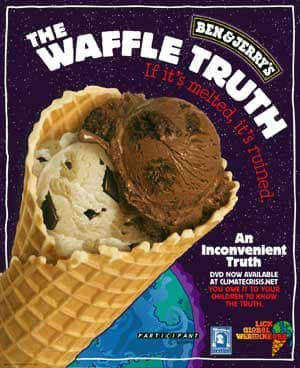 Working with the Vermont Department of Education and Vermont Public Interest Research Group, Ben & Jerry’s provided a free DVD of the film to every high school in Vermont. Along with the DVD, we kicked off an Environmental Community Action Contest open to every high school student in Vermont. We asked students to send us their plan to “Green Up Vermont” and help slow global warming. The student submitting the strongest plan will receive a $2,000 grant to use in implementing their program in 2007.
Working with the Vermont Department of Education and Vermont Public Interest Research Group, Ben & Jerry’s provided a free DVD of the film to every high school in Vermont. Along with the DVD, we kicked off an Environmental Community Action Contest open to every high school student in Vermont. We asked students to send us their plan to “Green Up Vermont” and help slow global warming. The student submitting the strongest plan will receive a $2,000 grant to use in implementing their program in 2007.
Reaching out to the college audience, we also sponsored Truth on Campus, a collaborative effort of nonprofits and like-minded companies to support screenings of An Inconvenient Truth on hundreds of college campuses across the country in the fall of 2006. Truth on Campus also helps students and colleges take action to address the climate challenge.
As for folks we couldn’t reach through school, we thought we might reach them through their taste buds. So we concocted a special menu item for our Scoop Shops called “The Waffle Truth” (cousin to An Inconvenient Truth?) and used it to promote the DVD release of the film. Posters of this special waffle cone sundae in approximately 300 of our Scoop Shops drove traffic to LickGlobalWarming.org where consumers could learn more.
FAIR TRADE MONTH
 During Fair Trade Month (October), we used our website, our Scoop Shops, and our Fair Trade Certified Coffee ice cream to raise awareness among consumers about how buying Fair Trade ingredients improves the quality of life for farmers in the developing world.
During Fair Trade Month (October), we used our website, our Scoop Shops, and our Fair Trade Certified Coffee ice cream to raise awareness among consumers about how buying Fair Trade ingredients improves the quality of life for farmers in the developing world.
In October 2006, Ben & Jerry’s joined our partners at Transfair USA to celebrate Fair Trade Month with a national program designed to generate awareness of Fair Trade Certified products.
We sent a Chunkmail message to our die-hard fans and created messaging for Ben & Jerry’s Scoop Shops to drive traffic to a dedicated Fair Trade page on our website. About 10,000 people found their way to the site. Once there, visitors could learn more about the Fair Trade movement, Transfair USA, and Ben & Jerry’s Fair Trade purchasing. In addition, web visitors could enter to win a guided tour of Costa Rica, including visits to three Fair Trade Certified 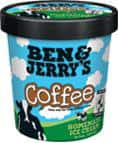 farms.
farms.
Here in our own backyard of Burlington, Vermont, we sponsored the taping of an etown radio program on the subject of Fair Trade and scooped our Fair Trade Certified Coffee ice cream at the event. We also sampled our Coffee ice cream at Burlington’s October premiere of the film Black Gold, which offers a sobering look at challenges and opportunities in the global coffee industry.
Ben & Jerry’s believes that Fair Trade certification is an important way to insure that our purchasing is making a positive impact in producing areas of developing countries. By guaranteeing farmers higher prices for their harvests, Fair Trade certification enables farmers to reinvest in their land and their communities.
We are excited to be increasing our company’s Fair Trade purchasing in 2007, and we’re pleased to help spread the word about this growing movement.
SMALL AND MID-SIZED FAMILY FARMS
 We launched this campaign in 2005 in collaboration with the Union of Concerned Scientists and the National Farmers Union, pushing for a national farm policy that creates a level playing field for small and mid-sized family farmers as they compete against industrial agriculture. In 2006, Congress did move to extend the basic safety net for America’s farmers.
We launched this campaign in 2005 in collaboration with the Union of Concerned Scientists and the National Farmers Union, pushing for a national farm policy that creates a level playing field for small and mid-sized family farmers as they compete against industrial agriculture. In 2006, Congress did move to extend the basic safety net for America’s farmers.
A lot of what’s good about Vermont — and Ben & Jerry’s — comes from family farms. We’re thankful for their contribution. We’re also concerned about their survival under pressure 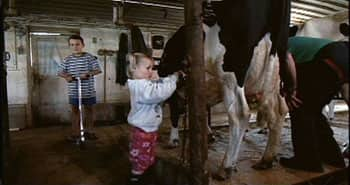 from giant industrial farming operations, encroaching urban development and economic shifts that urge farmers to get big or get out.
from giant industrial farming operations, encroaching urban development and economic shifts that urge farmers to get big or get out.
In 2006, we continued our campaign to raise awareness about the plight of family farms with a Family Farms webpage on the Ben & Jerry’s site. On this site, visitors could learn more about key issues, discover how Ben & Jerry’s supports family farmers with our purchasing, 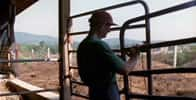 find timely action steps to take on behalf of small and mid-sized family farms, and link to our partners at the National Farmers Union (NFU) and the Union of Concerned Scientists (UCS).
find timely action steps to take on behalf of small and mid-sized family farms, and link to our partners at the National Farmers Union (NFU) and the Union of Concerned Scientists (UCS).
Our Call to Action for most of 2006 urged Congress to craft a 2007 Farm Bill that will protect small and mid-sized farms while limiting the expansion of industrial agriculture. Without an active effort to drive visitors to this page, web traffic was light.
The Edible Social Mission
MILKSHAKES - NEW FOR 2006!
In 2006, Ben & Jerry’s introduced a new line of bottled milkshakes in three of our classic flavors: Chocolate Fudge Brownie, Chunky Monkey, and Cherry Garcia.  The milkshakes are marketed under a multi-year licensing agreement with the Pepsi Cola Company. Made with milk from cows who are never treated with rBGH, and packed in recyclable glass bottles, these new milkshakes are right in line with our long-held company values. Even better, Ben & Jerry’s has dedicated a portion of the proceeds from these milkshakes to the purchase of carbon offsets through Clean Air, Cool Planet, which provides funding for the construction of new renewable energy projects. In 2006, these carbon offsets totaled $102,107.
The milkshakes are marketed under a multi-year licensing agreement with the Pepsi Cola Company. Made with milk from cows who are never treated with rBGH, and packed in recyclable glass bottles, these new milkshakes are right in line with our long-held company values. Even better, Ben & Jerry’s has dedicated a portion of the proceeds from these milkshakes to the purchase of carbon offsets through Clean Air, Cool Planet, which provides funding for the construction of new renewable energy projects. In 2006, these carbon offsets totaled $102,107.
ROYALTIES
Sharing ice cream is an unqualified good thing, and so is sharing some of the money we make on sales of our ice cream with groups out to make a difference. In 2006, three flavors of Ben & Jerry’s produced royalties to support causes closely aligned with our values.
Phish Food®
 Although legendary Vermont band Phish played their last concert in 2004, their unquenchable energy lives on through Ben & Jerry’s Phish Food ice cream and frozen yogurt. These flavors pay a royalty to the Waterwheel Foundation which is dedicated to the protection and preservation of Lake Champlain and its watershed. In 2006, royalties totaled $303,310.
Although legendary Vermont band Phish played their last concert in 2004, their unquenchable energy lives on through Ben & Jerry’s Phish Food ice cream and frozen yogurt. These flavors pay a royalty to the Waterwheel Foundation which is dedicated to the protection and preservation of Lake Champlain and its watershed. In 2006, royalties totaled $303,310.
Dave Matthews Band’s Magic Brownies™
As the main course in our ongoing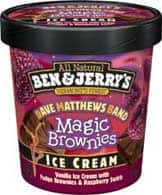 Lick Global Warming campaign, Dave’s Magic Brownies combines the spirit of Dave Matthews Band, the razzle of chocolate and raspberries, and the conscience of Mother Earth in one place. A portion of every sale of Dave Matthews Band Magic Brownies goes to Dave Matthews Band’s Bama Works Fund to support the work of nonprofit groups taking action against global warming. In 2006, this flavor produced royalties of $53,010 for Bama Works.
Lick Global Warming campaign, Dave’s Magic Brownies combines the spirit of Dave Matthews Band, the razzle of chocolate and raspberries, and the conscience of Mother Earth in one place. A portion of every sale of Dave Matthews Band Magic Brownies goes to Dave Matthews Band’s Bama Works Fund to support the work of nonprofit groups taking action against global warming. In 2006, this flavor produced royalties of $53,010 for Bama Works.
Butter Pecan
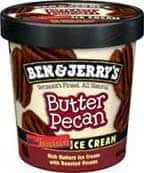 Continuing a relationship we’ve had for many years, sales of our Butter Pecan ice cream paid out royalties of $67,785 to the Tom Joyner Foundation in 2006. Tom Joyner hosts a top-rated, nationally syndicated morning radio show and a television show that airs in over 30 states. The Tom Joyner Foundation is a nonprofit foundation that provides assistance to students at Historically Black Colleges and Universities.
Continuing a relationship we’ve had for many years, sales of our Butter Pecan ice cream paid out royalties of $67,785 to the Tom Joyner Foundation in 2006. Tom Joyner hosts a top-rated, nationally syndicated morning radio show and a television show that airs in over 30 states. The Tom Joyner Foundation is a nonprofit foundation that provides assistance to students at Historically Black Colleges and Universities.
Organic Ice Cream
Since 2003, our line-up has included four organic ice cream flavors (Chocolate Fudge Brownie, Strawberry, Sweet Cream & Cookies, and Vanilla)  which are distributed primarily to natural foods stores in selected markets. We think the broader adoption of organic methods in agriculture is a step in the right direction towards a more environmentally sound food system. While our organic line performs at a lower rate than we had hoped, we’re pleased to be sourcing ingredients for these flavors that are produced without the use of synthetic pesticides or fertilizers.
which are distributed primarily to natural foods stores in selected markets. We think the broader adoption of organic methods in agriculture is a step in the right direction towards a more environmentally sound food system. While our organic line performs at a lower rate than we had hoped, we’re pleased to be sourcing ingredients for these flavors that are produced without the use of synthetic pesticides or fertilizers.
Body & Soul
Knowing that some folks are looking for healthier alternatives in their diets but still seek ice cream from time to time, we launched a line called Body & Soul in iconic Ben & Jerry’s flavors in 2005. These flavors have 25% less fat, sugar and calories than their full fat counterparts but remain 100% all natural and certifiably Ben & Jerry’s.
 After slow sales of the line in 2005, we kept only two flavors, Body & Soul Cherry Garcia and Chocolate Chip Cookie Dough, in limited distribution for 2006, and these will be discontinued in 2007. We recognize that it’s not the first time we’ve met with a lukewarm response when we introduced lighter options to our flavor line-up, and, unchastened, we’ll be trying again with a new “Lighten Up!” line in 2007 in a variety of different flavors. We’re motivated to keep working in our kitchen to come up with recipes and formulations that meet our exacting standards and the expectations of ice cream lovers who are watching their calories. However, we’ll also take it as a compliment that our diehard fans are looking for the real deal when they peer into the freezer.
After slow sales of the line in 2005, we kept only two flavors, Body & Soul Cherry Garcia and Chocolate Chip Cookie Dough, in limited distribution for 2006, and these will be discontinued in 2007. We recognize that it’s not the first time we’ve met with a lukewarm response when we introduced lighter options to our flavor line-up, and, unchastened, we’ll be trying again with a new “Lighten Up!” line in 2007 in a variety of different flavors. We’re motivated to keep working in our kitchen to come up with recipes and formulations that meet our exacting standards and the expectations of ice cream lovers who are watching their calories. However, we’ll also take it as a compliment that our diehard fans are looking for the real deal when they peer into the freezer.
Putting the “Elation” in Public Relations
We’re fortunate to have a brand that maintains a deep sense of integrity and an irreverent sense of humor, both woven tightly into the very fabric of our Company. Co-founder Jerry Greenfield really did say, “If it’s not fun, why do it?” and co-founder Ben Cohen really did say, “Business has a responsibility to give back to the community.”
So when it comes to Public Relations, we try to live up to the ideals of both of our founders. That means keeping things fun, representing the activities of our company honestly, and articulating our Company’s values along the way. The day-to-day work in our PR Department includes media relations, community relations, and handling numerous requests for information from a wide variety of people and organizations. The PR crew also manages product placements in television and movies, making sure our products are represented well through those media.
In 2006, the Public Relations Department played a central role in the success of the business, across a wide range of initiatives. PR was active in supporting the organization’s strategic planning, event-based and guerilla marketing campaigns, social mission initiatives, and ongoing community connections. Also in 2006, the PR Director’s position was combined with that of Social Mission Director and given a seat at the table of the MOM (Managers of the Mission, our senior leadership team) elevating the two functions within the organization.
2006 Highlights
Public Relations shot a sharp-tipped arrow of coverage into another bull’s-eye of results in 2006. With total impressions in the 2 billion range, the department’s efforts seem to have resonated with both consumers and the media. We had many upside moments to celebrate in 2006 and we had some bumps in the road from which we learned good lessons.
Newly released flavors including Turtle Soup and Black & Tan were well received stateside, while the latter created a bit of an international flap. Black & Tan was modeled after a popular half dark/half light beer served in pubs in the U.S. and around the world. Abroad, however, Irish media and citizens alike informed us that the term was also used to refer to much-maligned British paramilitary troops sent to defeat the Irish Republican Army in the early 1920s. We apologized for the misunderstanding to those offended by the unintended negative association and explained that it was a flavor produced only for the U.S. market, in which the meaning was entirely different than the historical connotations in the United Kingdom. As a global brand now, it’s clear that we need to be more aware of potential cross-cultural misunderstandings when we plan for product launches.
One new flavor that garnered plenty of positive media attention was American Pie, the centerpiece of our Social Mission campaign to draw attention to federal budget priorities. Co-founders Jerry Greenfield and Ben Cohen willingly carried this campaign on their shoulders, embarking on an East Coast media tour that resulted in exceptional coverage from The Washington Post, Boston Globe, CNN, Time, and local media throughout the region. Ben and Jerry were terrific spokesmen for the campaign to prioritize the basic unmet needs of children over spending on nuclear weapons programs, and the public seemed as eager to eat up the message as they did the flavor.
Another highlight of the year, which brought out our irreverent side, was our Do Us A Flavor contest in the summer of 2006. Using a web-based ‘flavor generator’ tool on our website, we sent out an open invitation to Ben & Jerry’s fans around the world to create their very own ice cream flavor. We thought the 90-day contest would appeal to a few thousand of our most hardcore fans, but when we received 14,000 suggestions in just the first few weeks, we realized we’d severely underestimated the appeal of the contest. We ended up with a whopping 40,000 entries, ranging from a dill pickle flavor to the winner, Puttin’ on the Ritz. We brought five finalists to Vermont for the final judging, which gathered some fun national media coverage.
The eggs we use in our ice cream created the most challenging PR moment in 2006. The Humane Society of the United States contacted us about the fact that our eggs came from conventional egg farms that employed caged management of their egg-laying hens. With this prompting, we looked into the issue to better understand it. As we reviewed the issue and possibilities for transitioning to cage-free egg suppliers, the clock was ticking. HSUS kept the heat on through a web-based campaign that started late in the summer and continued into autumn. The campaign put Ben & Jerry’s in an unfavorable light and gathered some uncomfortable media attention as well. After we completed our due diligence on the issue, we did end up in the place we wanted, committing to a total transition to certified-humane cage-free eggs over a four year period, starting in 2007. In the end, the experience pointed out the challenges of working within a larger, more complex supply chain, in which it can be harder to navigate unforeseen issues nimbly and expediently.
From Your Lips to Our Ears
The Ben & Jerry’s Consumer Services Team knows firsthand what so much of the research shows: Ben & Jerry’s ice cream fans are likely to develop a personal relationship with our brand. So when the phone rings or the mail box fills up, we embrace the chance to make a real connection with our consumers. We’ve found most folks to be thoughtful, intelligent, and passionate about our ice cream and the values of our company. But regardless of the nature of the communication, we strive to listen carefully and capture the messages we receive in a format to ensure that consumer voices are heard within our company. Most of all, we welcome our customers to keep in touch.
Messages from 2006
Over 60,000 people took the time to contact us about our company’s products, practices, and Social Mission activities in 2006, up significantly from last year. The good news is that many of these contacts contained praise for Ben & Jerry’s, offering us compliments on our products, our environmental practices, or our Social Mission.

However, the majority of our contacts for the entire year came in a two-month period at the end of the summer when many consumers, spurred on by the Humane Society of the United States, called or wrote to encourage us to source the eggs we use in our ice cream from cage-free suppliers. Our Consumer Services department answered many phone calls on this topic and received almost too many e-mails and comments in our online comment box to count. We even opened a few old-fashioned letters from folks encouraging us to make the switch to cage-free. On the phone, some people were understanding and took the time to talk with us about the challenges involved in making the switch. Other callers shared their thoughts and hung up quickly, and some were just downright rude.
The message got through, though, and in October, Ben & Jerry’s announced it will transition to using entirely Certified Humane cage-free eggs over a four-year period beginning in 2007. It’s fair to say that consumer voices raised the profile of this issue within our Company and sped up a decision that we had been contemplating for some time. In the months that followed, we’re pleased to say that we got many calls thanking us for being one of the first major food manufacturers in the U.S. to source cage-free eggs. When it was all said and done, contacts regarding Animal Rights were up an astounding 44,666.66% over last year. Now, that’s a spike!
On all other issues, consumer contacts were up 7% in 2006. E-mail contacts increased 13%, letters declined 12.6%, and telephone calls were essentially flat. Our FAQ page saw less activity in 2006 than in 2005, down 15% from 2005 numbers. However, searches for our FAQ pages were up 8%, which is an indicator that our consumers are finding what they are looking for more easily without having to ask for help.
COMPLAINTS
The top three complaints we heard from consumers were the following:
- Product texture/temperature abuse (exposure to temperature fluctuations): We saw an increase of about 0.5% in the number of texture complaints over last year. This is a sign that our ice cream is being handled carefully in both our distribution chain and retail outlets, as sales have increased faster than the rate of complaints.
- Ratio/Size (add-ins/ingredient issues): We experienced a 4.5% decrease in complaints about goodies in the mix (too small, too big, not enough, poor distribution or missing), a good sign that most people are finding what they expect when they crack open their pint.
- Franchise/Scoop Shop Complaints: We received an 11% increase in consumer contacts about their experience in Ben & Jerry’s Scoop Shops, with comments on everything from store cleanliness to customer service. Although that number is higher than we’d like, the feedback is important, and we work to address each issue as quickly as we can.
PRAISE
- Product: We saw a 68% increase in the number of contacts praising our products. We heard from folks about favorite flavors, we received lots of pictures of people and other creatures enjoying our products, and we were contacted by many students doing projects. It’s always great to hear that folks love our products and want to know more about them!
- Environmental: The number of contacts in this category increased by 19% over 2005. People expressed approval of our environmental efforts, with our Lick Global Warming campaign being one of the top areas of focus. We’re thrilled to see an expanding national consciousness around global warming in particular, and this higher level of consumer interest encourages us to stay on the cutting edge of the movement to address climate change.
- Social Mission: Social Mission compliments were up 40% in 2006 but still well off of years prior to 2005. Comments received praised our American Pie Campaign about federal budget priorities, our support for small-scale family farms, and our Company Social Mission in general.
GLOBAL SOCIAL MISSION
To Yonder Shores
At a meeting of the Social Ventures Network in the early 90s, Ben and Jerry made the acquaintance of J. Sainsbury, head of the leading supermarket chain in the UK. After hearing about their commitment to social causes and tasting their euphoric ice cream, Sainsbury felt sure the brand would work on his side of the pond. And so, in July 1994, the first pints of Vermont’s Finest ice cream set sail for UK shores.
We started with Cherry Garcia, Chunky Monkey and Chocolate Fudge Brownie, introducing chunks and swirls the likes of which had never before been seen in the UK. It soon became apparent that Europeans had an appetite for these glorious concoctions, and from humble ambitions a truly global business was born.
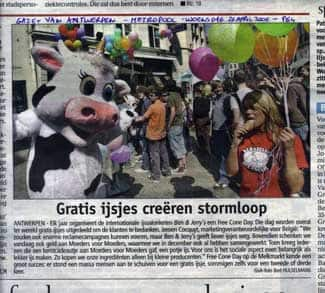 Since then, we’ve brought Peace, Love & Ice Cream to fifteen countries across Europe and the Middle East and seven in Asia and Latin America. In the UK, Ireland, and the Netherlands, Ben & Jerry’s has achieved market leadership. To keep the ice cream coming wherever it’s needed, we now have manufacturing operations in the Netherlands, Canada and Israel. Altogether, at the end of 2006, Ben & Jerry’s global business outside the U.S. was growing at 27% annually and worth well over $90 million.
Since then, we’ve brought Peace, Love & Ice Cream to fifteen countries across Europe and the Middle East and seven in Asia and Latin America. In the UK, Ireland, and the Netherlands, Ben & Jerry’s has achieved market leadership. To keep the ice cream coming wherever it’s needed, we now have manufacturing operations in the Netherlands, Canada and Israel. Altogether, at the end of 2006, Ben & Jerry’s global business outside the U.S. was growing at 27% annually and worth well over $90 million.
Around the world, as in the U.S., we remain committed to our Social Mission. We’ll be the first to admit that sometimes it’s a challenge to translate our ideals across a diversity of cultures, and we’ve taken our share of unexpected detours along the way. In a few countries, we’ve struggled to get our business established and Social Mission hasn’t gotten far off the starting line. But with the local knowledge of Ben & Jerry’s Brand Champions in key global markets and a full-time European Manager of Environmental Sustainability and Social Mission, we’re making substantive progress on our Social Mission overseas.
Caring Dairy
In 2003, Ben & Jerry’s launched Caring Dairy, a collaborative project that works directly with dairy farmers in the Netherlands on continuous improvement of the environmental, social, and economic performance 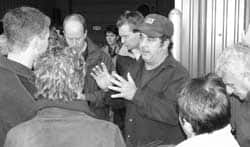 of their operations. Our partners in this effort include Unilever’s Sustainable Agriculture Initiative, our milk supplier, local farmers and Wageningen University.
of their operations. Our partners in this effort include Unilever’s Sustainable Agriculture Initiative, our milk supplier, local farmers and Wageningen University.
The project’s final objective is the development of guidelines for sustainable dairy farming, which will be completed in 2008 and made freely accessible to all participating farmers and the public at large.
 Caring Dairy helps farmers keep an eye on eleven indicators of sustainable dairy farming related to soil fertility and health, soil loss, nutrients, pest management, biodiversity, farm economics/value chain, energy, water, social/human factors, impact on local economy and animal welfare.
Caring Dairy helps farmers keep an eye on eleven indicators of sustainable dairy farming related to soil fertility and health, soil loss, nutrients, pest management, biodiversity, farm economics/value chain, energy, water, social/human factors, impact on local economy and animal welfare.
In October 2006, we took all participating Caring Dairy farmers and their families to Ben & Jerry’s home base in Vermont. During their week-long visit, the Caring Dairy 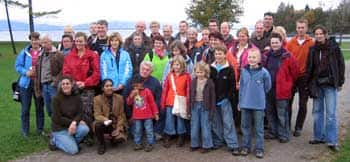 farmers had a chance to share ideas with some of the Vermont farmers who supply dairy ingredients for Ben & Jerry’s U.S. production and who participate in the Dairy Stewardship Alliance, a Ben & Jerry’s initiative to encourage sustainable dairy farming in Vermont. The Caring Dairy farmers also had a chance to connect with the brand’s origins, taking a tour of Ben & Jerry’s flagship ice cream factory in Waterbury, Vermont and meeting with co-founder Jerry Greenfield.
farmers had a chance to share ideas with some of the Vermont farmers who supply dairy ingredients for Ben & Jerry’s U.S. production and who participate in the Dairy Stewardship Alliance, a Ben & Jerry’s initiative to encourage sustainable dairy farming in Vermont. The Caring Dairy farmers also had a chance to connect with the brand’s origins, taking a tour of Ben & Jerry’s flagship ice cream factory in Waterbury, Vermont and meeting with co-founder Jerry Greenfield.
 We plan to complete the exchange program in 2007, when some of Ben & Jerry’s Vermont-based farmers will visit the Netherlands to gain a European perspective on dairying and the growth of Ben & Jerry’s overseas.
We plan to complete the exchange program in 2007, when some of Ben & Jerry’s Vermont-based farmers will visit the Netherlands to gain a European perspective on dairying and the growth of Ben & Jerry’s overseas.
We’re pleased that the impact of Caring Dairy is rippling outward from our initial group of participating farmers. We are actively sharing outcomes from Caring Dairy in the dairy industry, including in the Sustainable Agriculture Initiative Platform (SAI) Working Group on Dairy, a food sector initiative with over twenty global food companies.
Environmental Management —
The Netherlands
In 2002, to support our expanding market in Europe, we began producing Ben & Jerry’s ice cream at a Unilever facility in Hellendoorn, the Netherlands. Although Ben & Jerry’s represents just a part of this factory’s production, we’ve had a big impact on the plant’s approach to business. For example:
- Inspired by Ben & Jerry’s environmental commitment, Hellendoorn was the first industrial facility in Holland to meet all of its electricity needs with 100% renewable energy, including wind power, biomass and hydro-electric generation.
- Ben & Jerry’s helped the Hellendoorn plant to implement environmental management programs that will drive continuous improvements in energy efficiency, water use, and waste management.
In 2006, we set a goal to reduce the global warming impact of Ben & Jerry’s ice cream made for the European market. With a team of technical experts, an external energy efficiency consultant, and a consortium of NGOs, we completed a detailed assessment of the CO2 emissions that are created in the process of turning dairy products into Ben & Jerry’s ice cream and delivering our products to market. This ice cream “life-cycle analysis” revealed several opportunities for reducing greenhouse gases associated with our products. In response, we will be pursuing heightened energy efficiency measures at our Hellendoorn plant in 2007, including:
- Improved insulation in utility and product pipes in the facility
- Insulation of product transport conveyor belts
- Improved energy consumption monitoring systems and processes
- Installation of movement detectors on appropriate lighting systems
We also committed in 2007 to purchasing carbon offsets that meet the Gold Standard to counter-balance the emissions associated with our business. These offsets will invest in clean energy projects in developing countries.
Learn more about this European environmental initiative.
Global Values-Led Sourcing
 As in the U.S., our Global Values-Led Sourcing efforts seek to source raw materials and ingredients in a way that uses the brand’s buying power to drive positive social and environmental change. (Check out our U.S. Values-Led Sourcing initiatives). Going the extra mile for Values-Led Sourcing is not always an option. At times, we’re unable to find the quality we need, supplies aren’t up to our specifications, or costs exceed what we can sustainably afford. But we have found some good opportunities to make our European supply chain into a force for change.
As in the U.S., our Global Values-Led Sourcing efforts seek to source raw materials and ingredients in a way that uses the brand’s buying power to drive positive social and environmental change. (Check out our U.S. Values-Led Sourcing initiatives). Going the extra mile for Values-Led Sourcing is not always an option. At times, we’re unable to find the quality we need, supplies aren’t up to our specifications, or costs exceed what we can sustainably afford. But we have found some good opportunities to make our European supply chain into a force for change.
Fairtrade Certified
 In July 2006, we introduced Europe’s first ice cream made with Fairtrade Certified ingredients: Ben & Jerry’s Fairtrade Vanilla. All of the vanilla extract — and sugar — used in this ice cream is produced by cooperatives of farmers who are guaranteed to earn a fair price for their crops; have access to reasonable credit; use environmentally sound
In July 2006, we introduced Europe’s first ice cream made with Fairtrade Certified ingredients: Ben & Jerry’s Fairtrade Vanilla. All of the vanilla extract — and sugar — used in this ice cream is produced by cooperatives of farmers who are guaranteed to earn a fair price for their crops; have access to reasonable credit; use environmentally sound 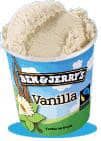 methods of cultivation; and meet several other standards of the Fairtrade Labeling Organizations Internatioinal (FLO). We’re proud to be a part of the growing Fairtrade movement around the world that is helping small farmers in the developing world to earn a decent living, stay on their land, and send their children to school.
methods of cultivation; and meet several other standards of the Fairtrade Labeling Organizations Internatioinal (FLO). We’re proud to be a part of the growing Fairtrade movement around the world that is helping small farmers in the developing world to earn a decent living, stay on their land, and send their children to school.
Learn more about the farmers in India and Paraguay who grow the vanilla and sugar we use in our Fairtrade Vanilla ice cream.
We are committed to the ideals of Fairtrade, and hope to introduce more Fairtrade flavors in 2007 and beyond.
Free-Range Eggs
People familiar with our brand know we believe that food production works best for people, animals and the environment when it occurs on family farms at a reasonable scale. As a result, we’ve tried wherever possible to source ingredients that reflect our commitment to animal welfare and the environment.
In Europe, Ben & Jerry’s sources only free-range eggs (‘vrije uitloop’) for use in our ice cream, believing it’s best for the chickens and the farmers involved. We pay a significant premium for these eggs above the cost of barn eggs or battery cage eggs.
Caring Dairy and rBGH
Although legal in the United States, the use of recombinant Bovine Growth Hormone (rBGH) to treat dairy cows is prohibited in Europe. That gives us one less thing to worry about when selecting ingredients for our ice cream produced abroad. So, in Europe, we’ve dedicated energy and resources to supporting and promoting the most progressive practices we could find in the field of sustainable dairy practices. Read more about our Caring Dairy initiative.
Learning to Be Cool
 In 2005 Ben & Jerry’s partnered with polar explorer Marc Cornelissen and the global environmental group WWF to kick off “Ben & Jerry’s Climate Change College” (CCC). The CCC is a three-year program that aims to raise awareness of climate change and motivate public action in Europe to reduce greenhouse gas emissions.
In 2005 Ben & Jerry’s partnered with polar explorer Marc Cornelissen and the global environmental group WWF to kick off “Ben & Jerry’s Climate Change College” (CCC). The CCC is a three-year program that aims to raise awareness of climate change and motivate public action in Europe to reduce greenhouse gas emissions.
Our first two years of CCC have been a huge success. We received 1500 applications and selected six young people from the UK and the  Netherlands to become our first class of climate change ambassadors in 2005. Through an e-learning program and a three-day college in London, the ambassadors received intensive training in the science of climate change, techniques for effective advocacy, and media relations.
Netherlands to become our first class of climate change ambassadors in 2005. Through an e-learning program and a three-day college in London, the ambassadors received intensive training in the science of climate change, techniques for effective advocacy, and media relations.
In May 2006, these six ambassadors traveled to Greenland on a two-week expedition to perform hands-on climate research on the ice cap and to meet Inuit people who are experiencing some of the most dramatic effects of climate change. The experience prepared these young people to 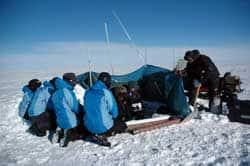 lead awareness campaigns in their home countries in support of WWF’s climate change action initiative.
lead awareness campaigns in their home countries in support of WWF’s climate change action initiative.
In 2006, we chose six new climate change ambassadors from the UK, the Netherlands, Ireland and Germany after an innovative application process that required candidates to submit a movie clip and a concrete campaign plan for spreading the word about climate change. We had a lot of fun at our selection weekend, 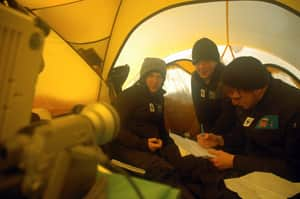 held in Outdoor Valley in Rotterdam, the Netherlands.
held in Outdoor Valley in Rotterdam, the Netherlands.
In 2007, we’ll look for eight more ambassadors to participate in the Climate Change College to keep spreading the word.
A Global Mission
We don’t have the space or time to tell you everything about how our Company’s partners around the world are acting on our Social Mission, but here’s a sampling. Feel free to visit Ben & Jerry’s website for more about our activities in specific countries.
The United Kingdom
- Three UK participants in Ben & Jerry’s Climate Change College, Ruth Cameron, Hayley Potter and Ben Richards, made us proud in 2006. Their CCC trip to Greenland, where they visited with Inuit people and participated in an international climate change research expedition on the Ice Cap, gathered over 20 million PR impressions and raised awareness of climate change in the UK. All three went on to campaign on climate change in their respective industries. Zookeeper Hayley instigated a ‘green team’ at the Colchester Zoo, successfully introducing a range of initiatives such as converting all animal dung into bio-gas to power enclosures, recycling cooking oil in on-site tractor vehicles, and implementing a waste recycling scheme. Insurance company communications assistant Ben Richards was promoted to CSR Manager for Climate Change in his company, and has started implementing a programme to engage his 12,000 co-workers in creating a sustainable office environment. Ruth Cameron was appointed the Scottish Co-ordinator for a coalition of environmental charities in the UK and plans to stand as Green MP in the 2007 Scottish Parliament elections. Recruitment for Year 2 students began in September, and 5 million young people were reached through a mix of cinema advertising, sampling and campus activity.
- 2006 saw the second Ben & Jerry’s
 Sundae on the Common Festival on Clapham Common in London. Top bands such as Badly Drawn Boy, Echo and the Bunnymen and The Wonderstuff played while punters enjoyed fairground attractions, a city farm, and free ice cream. Tickets were £5, which ensured that the 15,000 ticket capacity sold out in three hours. Proceeds of £25,000 ($45,500) proceeds were donated to a local Clapham Bandstand, paying for deckchairs and a series of free outdoor community concerts. We invited all of our nonprofit partners from the
Sundae on the Common Festival on Clapham Common in London. Top bands such as Badly Drawn Boy, Echo and the Bunnymen and The Wonderstuff played while punters enjoyed fairground attractions, a city farm, and free ice cream. Tickets were £5, which ensured that the 15,000 ticket capacity sold out in three hours. Proceeds of £25,000 ($45,500) proceeds were donated to a local Clapham Bandstand, paying for deckchairs and a series of free outdoor community concerts. We invited all of our nonprofit partners from the 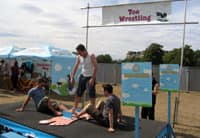 last few years to set up stalls at the festival, and WWF in particular witnessed record sign-ups to their latest campaign.
last few years to set up stalls at the festival, and WWF in particular witnessed record sign-ups to their latest campaign. - We launched the world’s first ever Fairtrade vanilla ice cream for the European market at the Sundae on the Common Festival. Our co-founder Jerry Greenfield and Paraguayian sugar farmer Luis Ruiz Diaz were present to celebrate this great milestone and talk to the press.
- Free Cone Day 2006 was a little smaller than last year, but plenty of fun. With 15 UK sites participating, we raised £4,000 for nominated charities at each site. In all, we gave away 18,000 scoops of ice cream.
- In 2006, the Company encouraged franchisees to step up local store Social Mission by offering a 20% reduction on bulk ice cream costs to the store most involved in the local community. There were two winners amongst our franchisees. Alex Fielden from Brighton scooped at charity school fetes all summer, sending all the proceeds to charity. Shaun Marris from Norwich assisted the local library reading programme by offering a free scoop to any child who read six books.
- On an eco-supply binge, we transitioned all Ben & Jerry’s company-owned stores in the UK and selected independent stores to Ecotricity, a green electricity provider and Ecover, a supplier of environmentally friendly cleaning products.
- Cresco Trust, our PartnerShop nonprofit partner in Derry, Northern Ireland, played host to the inaugural Global Social Enterprise Forum in September. The Forum brought together inspirational examples of social enterprise success from across the world, including keynote addresses from leading visionaries such as Charles Lief of the Hartland Group, Gordon DaSilva from Training For Life and our very own beloved co-founder Jerry Greenfield. The Forum was followed by the annual PartnerShop conference, hosted outside the US for the very first time.
- Our retail team also found time to open our third UK PartnerShop, in Aberdeen, Scotland with nonprofit group Aberdeen Foyer. Aberdeen Foyer provides supported accommodation and access to a range of education, training and employment opportunities for young people aged 16-25. The Foyer works to enable homeless and disadvantaged young people achieve social and economic independence. This shop is the first Ben & Jerry’s in Scotland.
We celebrated Free Cone Day 2007 in 12 scoop shops across Germany, scooping 16,400 scoops to thank our customers for their support in the previous year and collecting €2,000 for local NGO partners. In Cologne, for example, we supported “Wir für Pänz” an organisation that takes care of disadvantaged children.
In May we started a college Tour with our Climate Change Ambassador Julian v. Blücher. We visited 13 Universities in 15 days, promoting his project to use University building rooftops to generate solar electricity, and to raise awareness of climate change. Julian’s efforts so far have brought five Universities on board to install solar panels and save tons of CO2.
Around Christmas time, we started a “Let’s build a snowman” game on our Ben & Jerry’s website. Visitors could send an e-card to a friend in the form of a snowball, with a €1 donation for each snowball going to Nordlicht, an NGO that helps children develop self-confidence. In total 2,400 e-snowball e-cards were sent, raising €2,400.
The Netherlands
- Ten Ben & Jerry’s Shops participated in Free Cone Day 2006, handing out 15,000 scoops of ice cream to happy passers-by. Once again, we raised significant awareness and money for our nonprofit partner, War Child, an NGO that rehabilitates former child soldiers in third world countries.
- Getting good PR out of Free Cone Day is difficult in the Netherlands, because wary media consider our worldwide event too commercial. In an attempt to get their attention, we decided to create the “IJsvrij-Award” and give it to another company making a significant but unnoticed contribution to a better world. With a Dixieland band at our side, the staff of Ben & Jerry’s and our NGO partner War Child surprised the office of the award-winning advertising agency Imagine with a visit at noon. We offered them the afternoon off, a year’s supply of ice cream and, of course, a lot of respect for help they give to charities such as War Child. At the end of the awards ceremony, we all walked to the nearest Scoop Shop to celebrate this award with live music from the band and a DJ. It was big fun!
- Climate Change College. Our first-year Dutch Climate Ambassadors, back from Greenland, prepared to launch their Green House campaign, a service for new house owners to get green energy at home by signing just one document. Meanwhile, we toured through the Netherlands again with our airstream caravan to recruit applicants for the second year of the Climate Change College.
- During the summer we love to visit all manner of festivals, spreading Peace, Love & Ice Cream via a wooden wagon, cow bean bags, flip-flops, t-shirts, polaroids and festival hats. But we also love to raise awareness and funds for our nonprofit partner, War Child. With our help, more than 400 new friends signed up with War Child in 2006, agreeing to regular monthly support for the group’s peace program in Sierra Leone.
- We also donated three freezers and 30 loads of Ben & Jerry’s ice cream to War Child for a unique corporate fundraising program. War Child staff “rented” each freezer full of ice cream to companies for one week at a time for €1000. Participating companies put the freezer in their reception area and used the ice cream to give away to their visitors and employees, while spreading the word about War Child and the partnership with Ben & Jerry’s. In all, War Child managed to raise €30,000 in support of their peace program in Sierra Leone this way. It was a great success and we’ll be running this tour again in 2007 with more ice cream!
- School Reading Program. One of our Amsterdam Scoop Shops is very popular with students at a nearby secondary school. The shop owner has encouraged students to read more by running a bookmark campaign. Students get their teacher’s initials on a bookmark each time they complete a book, and then exchange the bookmark for a free scoop at the Scoop Shop.
France
- In 2006, Ben & Jerry’s continued its partnership with the nonprofit organization French Blood Donation, providing free ice cream as an incentive to recruit and reward donors.
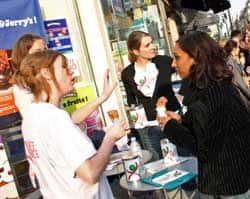 Ben & Jerry’s France celebrated Free Cone Day in more than 20 Scoop Shops and kiosks, giving away a grand total of 19,000 free cones. Our nonprofit partner for the day was Planète Urgence, an advocacy group focused on eliminating the economic disparities between countries in the Northern and Southern hemispheres and addressing global environmental issues. Planète Urgence collected about €1000 for the day in the highest visibility shops.
Ben & Jerry’s France celebrated Free Cone Day in more than 20 Scoop Shops and kiosks, giving away a grand total of 19,000 free cones. Our nonprofit partner for the day was Planète Urgence, an advocacy group focused on eliminating the economic disparities between countries in the Northern and Southern hemispheres and addressing global environmental issues. Planète Urgence collected about €1000 for the day in the highest visibility shops.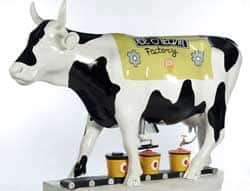 Ben & Jerry’s hired the French sculptor Frédéric Périmon to design two of the 60 cows making up part of the Vach’Art exhibition, a benefit for two NGOs fighting world hunger. Both cows were put up for auction at the famous bidding house “Drouot” and sold for a combined €40,000 to benefit “Africa Live” and “Programme Alimentaire Mondial”.
Ben & Jerry’s hired the French sculptor Frédéric Périmon to design two of the 60 cows making up part of the Vach’Art exhibition, a benefit for two NGOs fighting world hunger. Both cows were put up for auction at the famous bidding house “Drouot” and sold for a combined €40,000 to benefit “Africa Live” and “Programme Alimentaire Mondial”. During the second half of the year, Ben & Jerry’s established what’s meant to be a long term partnership with an NGO exceptionally in line with our values: RESEAU COCAGNE. Reseau Cocagne manages more than 80 gardens throughout the country called “Jardins de Cocagne” with the goal of employing the chronically unemployed, getting them off the streets and back into the work force. Today, the program works with more than 2,700 gardeners, 450 managers and 1,200 volunteers. We’ll let you know in the next report how our partnership evolved in 2007!
During the second half of the year, Ben & Jerry’s established what’s meant to be a long term partnership with an NGO exceptionally in line with our values: RESEAU COCAGNE. Reseau Cocagne manages more than 80 gardens throughout the country called “Jardins de Cocagne” with the goal of employing the chronically unemployed, getting them off the streets and back into the work force. Today, the program works with more than 2,700 gardeners, 450 managers and 1,200 volunteers. We’ll let you know in the next report how our partnership evolved in 2007!
Spain
- Again in 2006, we continued our Blood Donation Campaign in Spain with great success: almost 40,000 blood donors received a Ben & Jerry’s two scoop ice cream cone in 2006!
- We put new energy into supporting our franchisees’ commitment to Ben & Jerry’s Social Mission in 2006. On Free Cone Day, we served 70,691 scoops (a new record!) and almost all of our franchisees partnered with a local non-profit organization to raise awareness and funds.
- To celebrate Christmas, we collaborated with Cruz Roja Juventud on a sweet campaign to gather toys for underprivileged children. We also gave out Christmas postcards carrying a Social Mission message.
- Our partners this year have been:
- INOUT: a youth hostel working with mentally challenged youth. We raised €3,000 towards the construction of a new hostel wing.
- Fundación Theodora: a nonprofit organization that makes weekly visits with Doctores Sonrisas (Smile Doctors) to cheer up hospitalized children. Many sick children had happy and funny moments thanks to Ben & Jerry’s €3,000 donation this year.
- Fundación Natura: a progressive environmental organization. Our €3,000 donation helped efforts to fight climate change. In return, Fundación Natura advised our Scoop Shops on ways to reduce their environmental impacts.
- Barcelona’s public transport company (TMB). In a three week campaign we used ice cream incentives to encourage the use of public transportation. Messages throughout the subway system spread the word that people riding public buses and subways could stop in to Ben & Jerry’s for a free cone.
Germany
- We celebrated Free Cone Day 2006 in 12 scoop shops across Germany, thanking our customers for their support in the previous year and collecting donations for local NGOs. In Hamburg, for example, we supported Nordlicht, an organization that helps children develop self-confidence and non-aggressive problem solving skills.
- In 2006 Ben & Jerry’s Climate Change College (CCC) came to Germany for the first time. We launched a recruitment tour in our old Ben & Jerry’s bus,
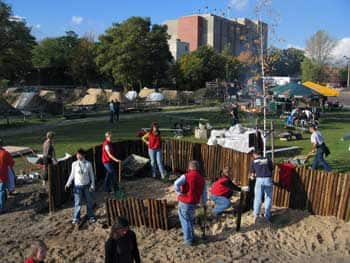 reaching out to over 100,000 young Germans at universities, music festivals and youth events. We were joined by Dutch polar explorer Marc Cornelisson who helped us raise awareness about global climate change and spread the word about how to reduce greenhouse gas emissions. From over 100 official applicants, we selected Julian v. Blücher to enroll in the 2007 Climate Change College. Julian will develop a campaign in 2007 focused on installing solar panels at universities.
reaching out to over 100,000 young Germans at universities, music festivals and youth events. We were joined by Dutch polar explorer Marc Cornelisson who helped us raise awareness about global climate change and spread the word about how to reduce greenhouse gas emissions. From over 100 official applicants, we selected Julian v. Blücher to enroll in the 2007 Climate Change College. Julian will develop a campaign in 2007 focused on installing solar panels at universities. 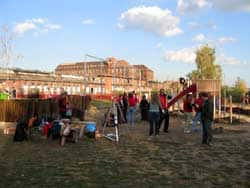 In October, the global Ben & Jerry’s meeting took place in Berlin. Central to the meeting was a community service project, in which Ben & Jerry’s employees from around the world built a playground for children in a socially difficult district of the city. In one remarkable day of work and fun, we completed the entire playground, with jungle gyms, ladders and slides.
In October, the global Ben & Jerry’s meeting took place in Berlin. Central to the meeting was a community service project, in which Ben & Jerry’s employees from around the world built a playground for children in a socially difficult district of the city. In one remarkable day of work and fun, we completed the entire playground, with jungle gyms, ladders and slides.
Ireland
- In 2006, Ireland joined the UK, the Netherlands and Germany in Ben & Jerry’s Climate Change College. The first order of business was to choose a Climate Change Ambassador from Ireland. After a whirlwind recruitment process, we chose Lesley Butler, who intends to ‘tackle the lack of action taken by small and medium enterprises (SME’s) in Ireland to combat Climate Change.’ Her objective is to establish environmental management schemes in 30 SME’s by the end of August 2007.
- In October 2006, Ben & Jerry’s Ireland launched the Cool Your Jets carbon offset tool powered by myclimate.org. We’re pleased to be making this important tool available to people in Ireland looking to reduce their climate impacts.
- Irish Scoop Shops participated in Free Cone Day 2006, offering free scoops of ice cream to all visitors and collecting voluntary donations to UNICEF Ireland.
Belgium
- In 2006 our goal was to extend the scope of our Social Mission activities beyond Antwerp. So in addition to our existing partnership with Mothers for Mothers in Antwerp, we started a partnership with ’t Vindcentje in the city of Gent. Both organizations are nonprofits that empower underprivileged parents to educate their children and optimize their own life skills and opportunities. During our “n’ICE Gift” project in the week before Christmas, Ben & Jerry’s encouraged shoppers in Gent and Antwerp to place a present under the Ben & Jerry’s Christmas tree for underprivileged families. We thanked donors for their generosity with a free scoop of Ben & Jerry’s ice cream. We collected about 1,000 presents in 2006 and distributed them through our nonprofit partners.
- 2006 was also the year in which Belgium’s first Fair Trade ice cream was launched: Ben & Jerry’s Vanilla. We distributed press packets and invited journalists for an interview with co-founder Jerry Greenfield. This generated more than 25 articles, promoting our ice cream but also promoting Fair Trade.
- On Free Cone Day, we handed out 2,000 free cones at our Scoop Shop in Antwerp and raised money for Mothers for Mothers to renovate their buildings.
Denmark
- Due to great consumer feedback in 2005, we decided to run a second round of our global warming awareness campaign in 2006, in which we put tips on reducing carbon emissions onto Ben & Jerry’s branded paper bags.
- We continued our work with Save the Children, a Danish organization dedicated to improving the physical and social environment for children. Ben & Jerry’s raised donations through various events and everyday collections. Unfortunately some of the donations were stolen, but we still managed to deliver €1000 for this partner.
- With peace and justice on our mind, we sponsored a number of events in 2006, including an event with the purpose of bringing together international students from all over the world to share their perspectives on life.
Sweden
- Sweden’s Social Mission efforts were mainly put into the grand Summer Scoop Tour 2006 where a mobile unit traveled across the country and gave out ice cream in exchange for a donation to one our nonprofit partners, United Sisters and 4-H. Both organizations aim to improve the well-being of young people. The tour kicked off with a big event in central Stockholm where local celebrities scooped ice cream and we raised over €2,000.
- With signs and posters in Scoop Shops and a special section of our web site, we used our resources to spread the word about Global Warming to consumers around the country.
Switzerland
- For the third year in a row Ben & Jerry’s Switzerland supported the Stiftung Zürcher Blutspendedienst SRK with free ice cream for blood donors in three major Swiss cities. We rewarded 8,100 donors with free ice cream.
- On Free Cone Day, Ben & Jerry’s shops in St. Gallen and Lucerne — and our partner Lolipop — raised money for the Stiftung Kinderdorf Pestalozzi, an NGO focused on supporting underprivileged youth from around the world by providing them with shelter and education, keeping them away from crime, and supporting integration through intercultural education. The two shop managers continued fundraising for this NGO after Free Cone Day as well.
Portugal
- In 2006 we proudly held the Grand Opening of our flagship store in Lisbon, located in an area with an interesting mixture of tourist traffic, youth and working people. Celebrity scoopers helped us make a splash. But even more important, we directed all sales from the day, nearly €5,000, to Instituition Vida e Paz (Life and Peace) an organization that serves people in need, including the homeless and those unable to reintegrate in society.
Mexico
- In 2006, a group of students hosted a Ben & Jerry’s stand at the Fast Food Fair of the TEC de Monterrey University. Along with the organization ‘Compartiendo la Alegría’ (Unified to Help), we raised funds for the purchase of necessary medical drugs (approx 200 packages) for needy people. Our ice cream was well received, too.
- Ben & Jerry’s also organized a ‘Save Water Campaign’ during the World Water Forum in Mexico City. Postcards were distributed in Scoop Shops with messages on the importance of taking care of our environment and husbanding our water reserves. Kids were invited to make drawings that showed how to save water, and they received a special button with a fun design related to the campaign when they handed it in.
Singapore
- Wildlife Reserves, the operators of the Ben & Jerry’s kiosks at the Singapore Zoo, raised funds in 2006 for the Wildlife Conservation Singapore Fund (WCSF). WCSF provides for the welfare and feeding of endangered/threatened animals at the Singapore Zoo and Night Safari and partially supports the cost for other education activities, research and conservation projects in Singapore.
- The Happy People Co., operators of Ben & Jerry’s city centre shops, raised funds for Amazing Kidz, a nonprofit providing support to children with brain injuries.
Hong Kong
- On Free Cone Day 2006, Ben & Jerry’s raised about US$8,000 for Friends of the Earth in Hong Kong.
- We held events and donated ice cream to support WWF’s Walk for Nature and a student booth at the Island School Fair.